My husband, Adam, and I have a quartet of major home-improvement projects slated for 2023, but we don’t know exactly when any of them will happen, which makes planning travel rather difficult. So when a window opened in mid-November, we looked into a trip to Paris—I’ve been dropping hints for years about revisiting the city. In the weird world of airfare pricing, however, flights to Istanbul via Paris were much cheaper, and flights to Istanbul via London were cheaper still. While my desire for Paris remains strong, I have to admit that telling people you’re headed to Istanbul is much more fun.
Our first and largest mistake was only going for five full days. We’re still in the East Coast mindset, I guess, that you can pop over to Europe for a few days. But from the West Coast, and particularly to the eastern edge of Europe, the travel is a bear and the jet lag is brutal. (The time difference between here and Istanbul is 11 hours.) We only got acclimated right as we were due to return home—so we were basically jet-lagged for 10 straight days. Plus, as much as I loved Istanbul, I don’t know that we’ll return anytime soon (i.e., ever, given our ages), which means we’ll probably never see Cappadocia, Bodrum, Ephesus, and wherever else people go in Turkey.
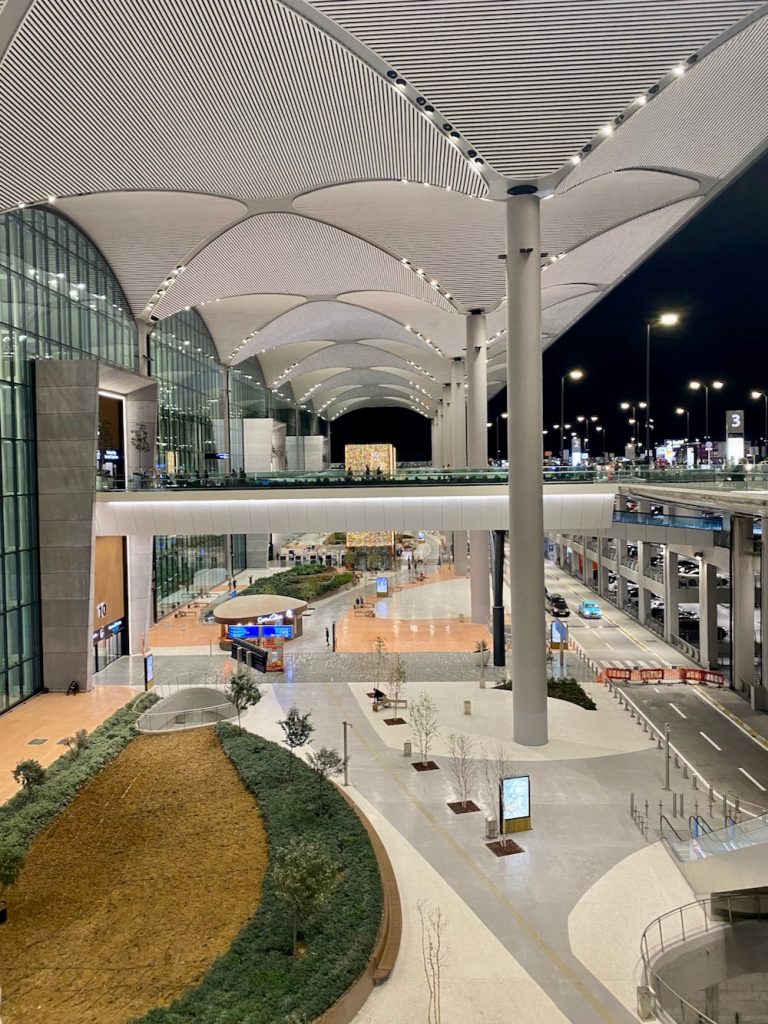 Istanbul is huge, with over 15 million residents, as you will notice when you fly in over all the sprawl. It’s also very much a modern city, as you can tell from the airport. We are big believers in being coddled after traveling for twenty hours, and taxis and Uber drivers in Istanbul are known to play fast and loose with fares. Instead, we used Blacklane, an international black-car service with which we’ve had good experiences in Mexico City, Buenos Aires, and New York, and we’d definitely recommend it.
Istanbul is huge, with over 15 million residents, as you will notice when you fly in over all the sprawl. It’s also very much a modern city, as you can tell from the airport. We are big believers in being coddled after traveling for twenty hours, and taxis and Uber drivers in Istanbul are known to play fast and loose with fares. Instead, we used Blacklane, an international black-car service with which we’ve had good experiences in Mexico City, Buenos Aires, and New York, and we’d definitely recommend it.
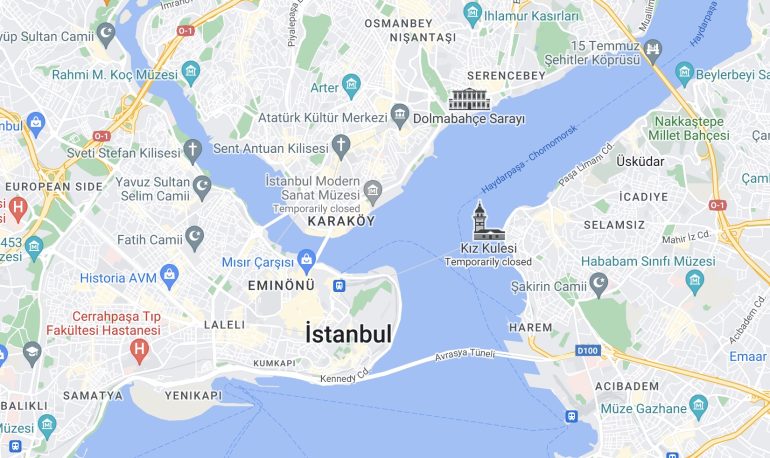 The biggest decision you will make in regard to a trip to Istanbul is where to stay—not just the hotel, but the area. The Sultanahmet neighborhood, where “Istanbul” is written in the above map, is home to the Hagia Sofia, the Blue Mosque, and other major historical attractions. But it’s relentlessly touristy. Across the Bosphorus Strait are neighborhoods—Karaköy, Cihangir, Çukurcuma—where locals are more likely to live and hang out, and that’s where the good restaurants tend to be. The problem is that getting between the two is a 45-minute walk through clogged streets or a drive that can take even longer, given the city’s horrendous traffic. Doing the walk once or twice was fine; doing it twice a night, especially after walking all day long, turned exhausting. Eventually, we figured out the tram and ferry systems, which we wished we had done upon arrival.
The biggest decision you will make in regard to a trip to Istanbul is where to stay—not just the hotel, but the area. The Sultanahmet neighborhood, where “Istanbul” is written in the above map, is home to the Hagia Sofia, the Blue Mosque, and other major historical attractions. But it’s relentlessly touristy. Across the Bosphorus Strait are neighborhoods—Karaköy, Cihangir, Çukurcuma—where locals are more likely to live and hang out, and that’s where the good restaurants tend to be. The problem is that getting between the two is a 45-minute walk through clogged streets or a drive that can take even longer, given the city’s horrendous traffic. Doing the walk once or twice was fine; doing it twice a night, especially after walking all day long, turned exhausting. Eventually, we figured out the tram and ferry systems, which we wished we had done upon arrival.
We stayed at the Four Seasons Sultanahmet, because we knew that as first-timers we’d be spending a lot of time in the neighborhood, and also because it just underwent a thorough renovation. And the hotel—a former prison!—was terrific. The more money I spend on accommodations, the more critical I’m going to be. In this case, however, I can’t think of a single negative thing to say. And the staff was a delight.
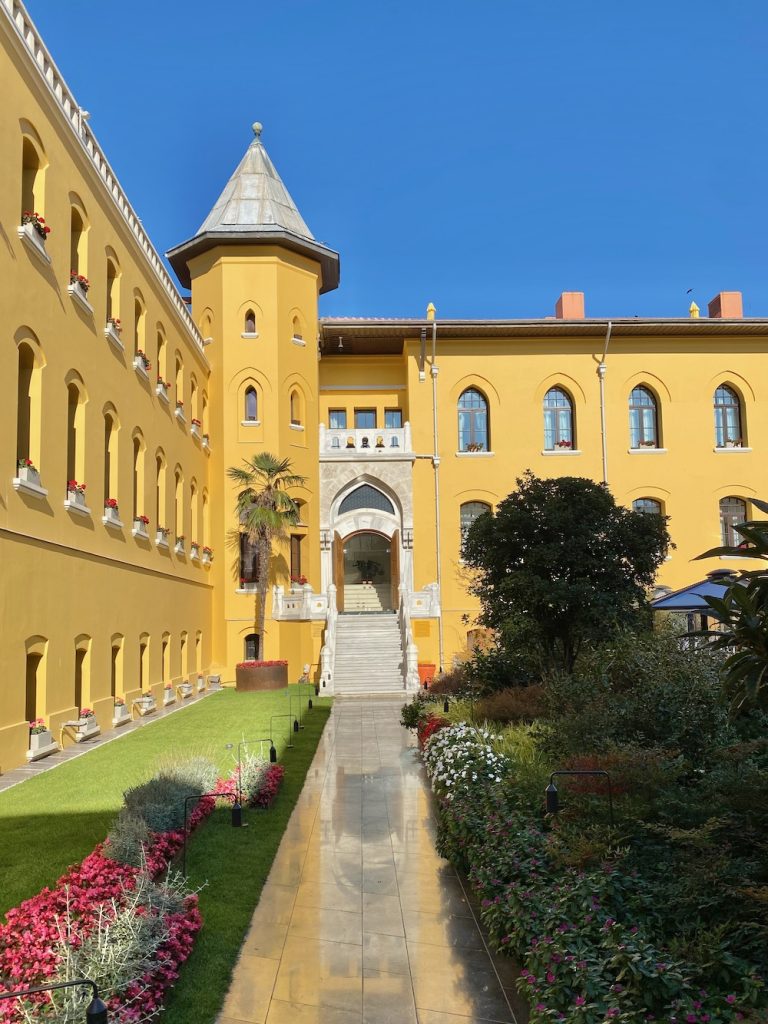
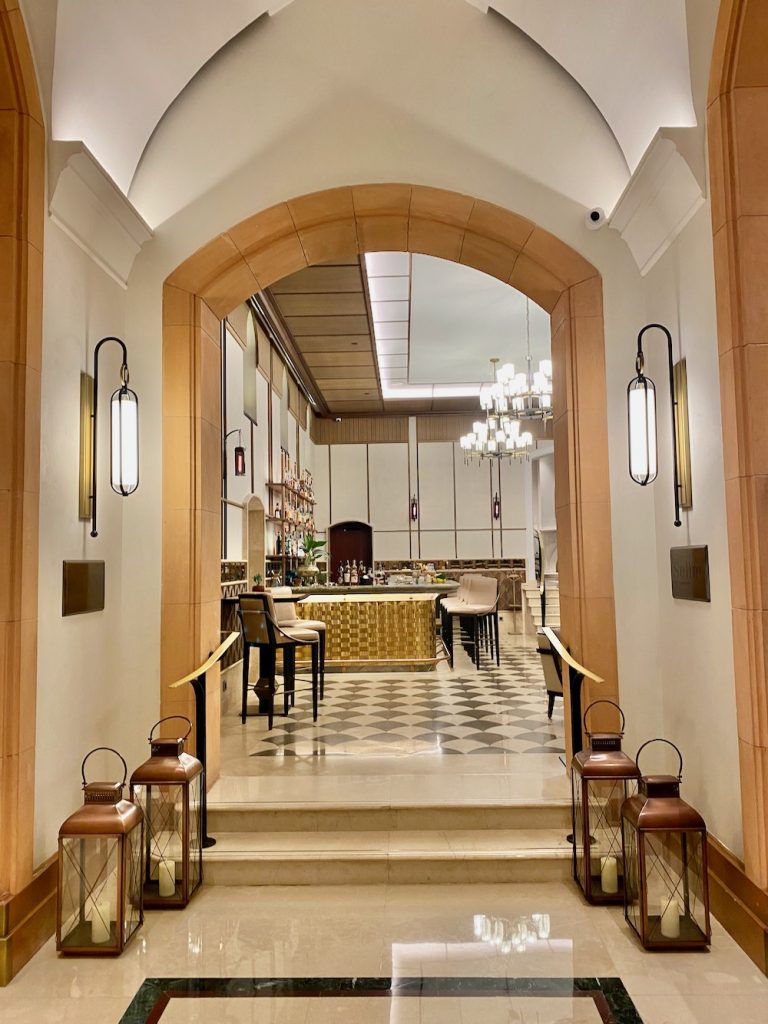
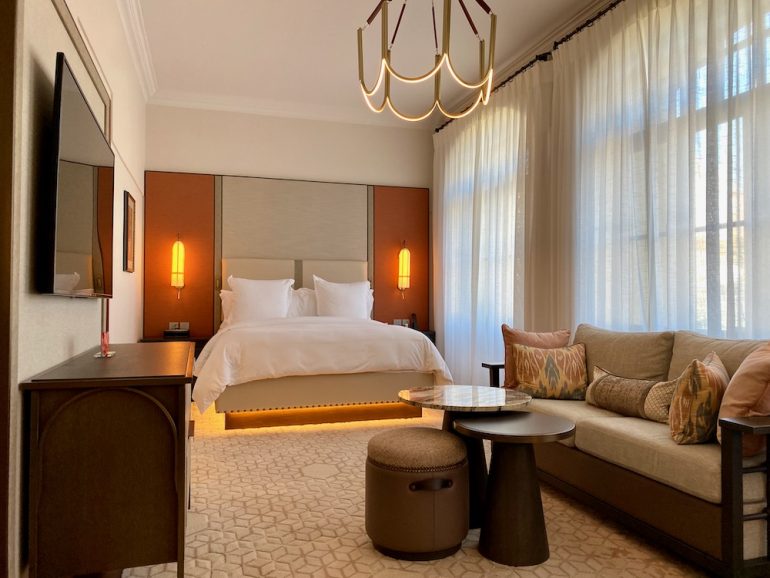 Our initial day was a blur: we arrived at 1 a.m. and the first of the day’s five calls to prayer was at 6:15 a.m. Even taking the early hour into consideration, the call to prayer is wonderfully evocative. Unfortunately, it comes out over a tinny loudspeaker that brought to mind “M*A*S*H,” and there’s a tendency to take long pauses between lines, which reminded us of the way flight attendants drift away in the middle of announcements. We would tell ourselves the muezzin was done, only to have him start up again.
Our initial day was a blur: we arrived at 1 a.m. and the first of the day’s five calls to prayer was at 6:15 a.m. Even taking the early hour into consideration, the call to prayer is wonderfully evocative. Unfortunately, it comes out over a tinny loudspeaker that brought to mind “M*A*S*H,” and there’s a tendency to take long pauses between lines, which reminded us of the way flight attendants drift away in the middle of announcements. We would tell ourselves the muezzin was done, only to have him start up again.
Any foreign city is at its most exotic at the outset, when you don’t have your bearings, the language is totally unfamiliar, and the quirky details pop. The sign below translates loosely to “safety first.” And we were there on the birthday commemoration of the death* of Mustafa Kemal Atatürk, the father of modern Turkey who is clearly still held in very high esteem. We wondered—but dared not ask—whether the displays might be meant as a rebuke to the country’s despotic president, Recep Tayyip Erdoğan. [*Thanks for the correction, V.]
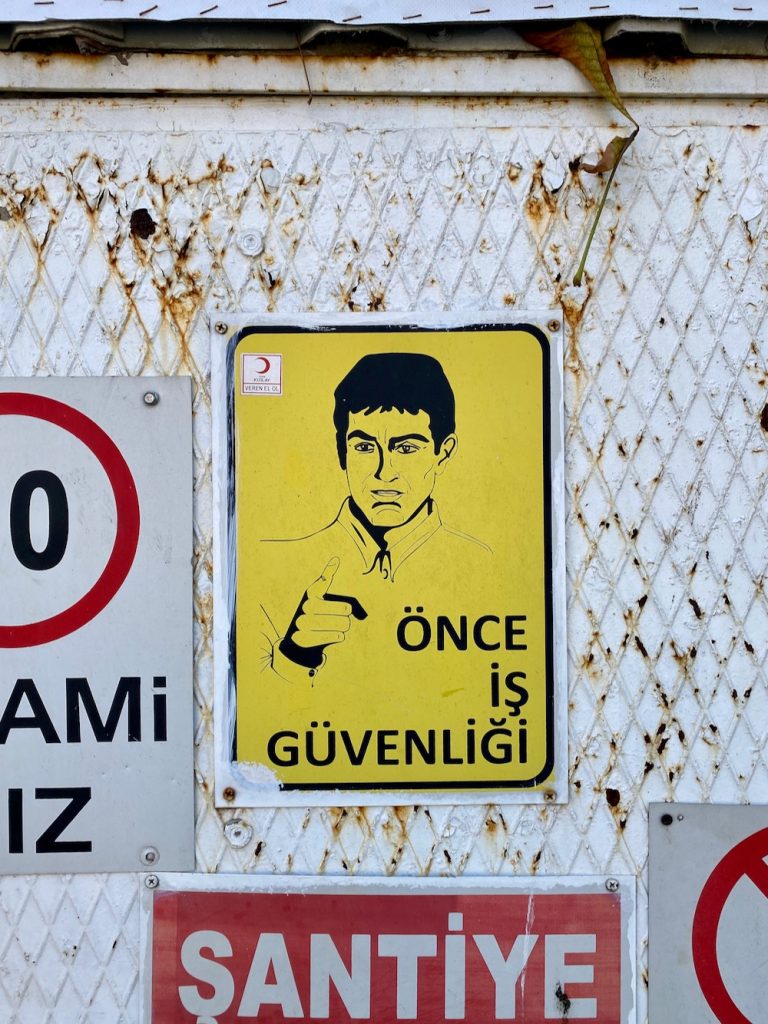
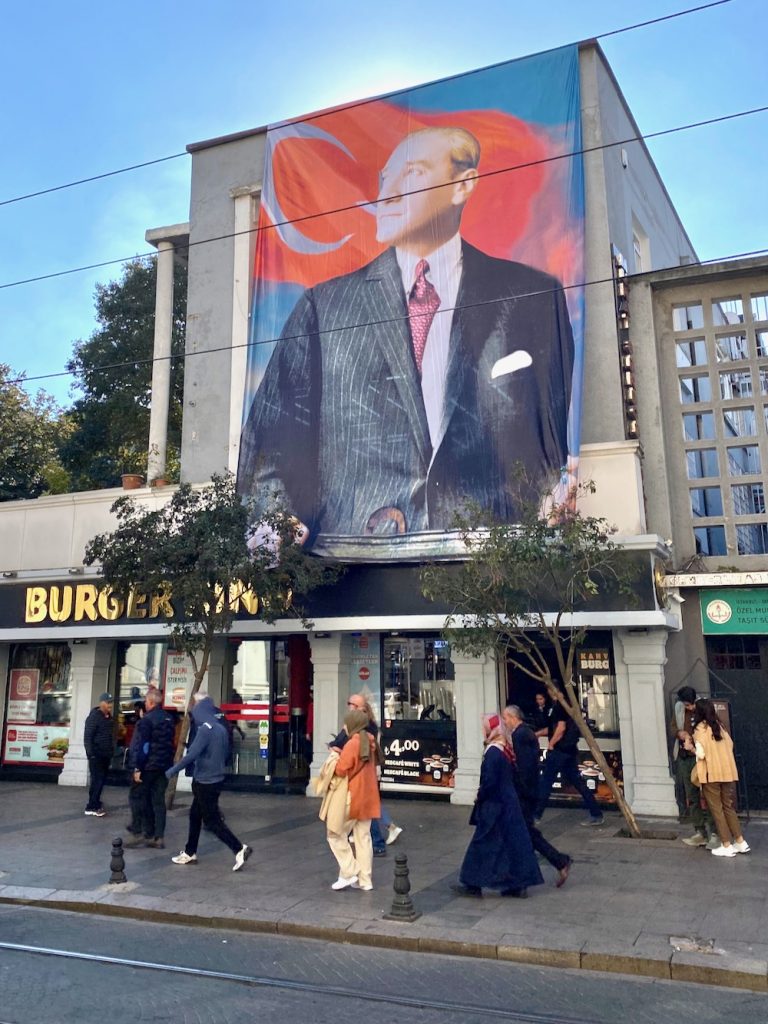
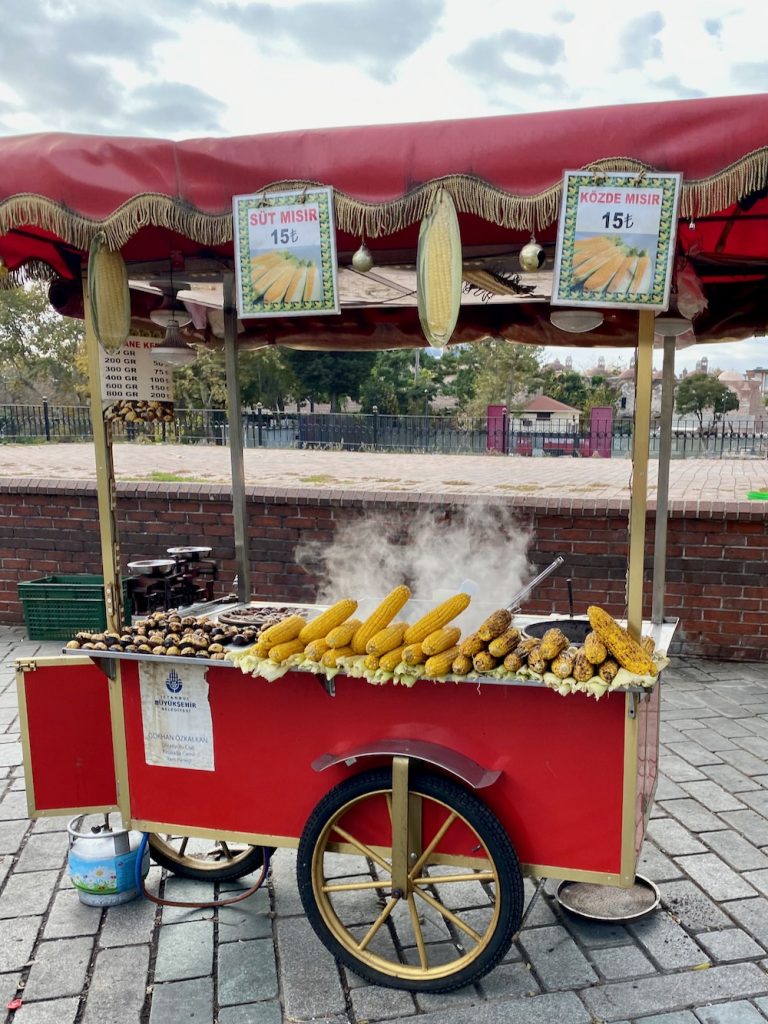
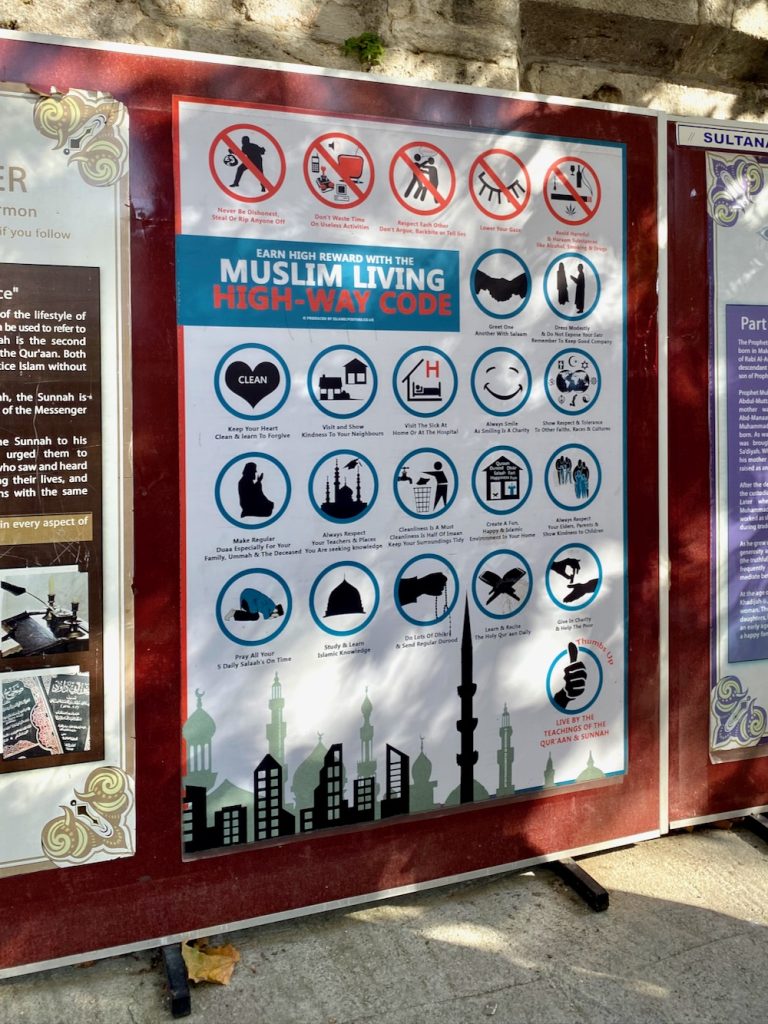 The way old and new coexist reminded us of Jerusalem.
The way old and new coexist reminded us of Jerusalem.
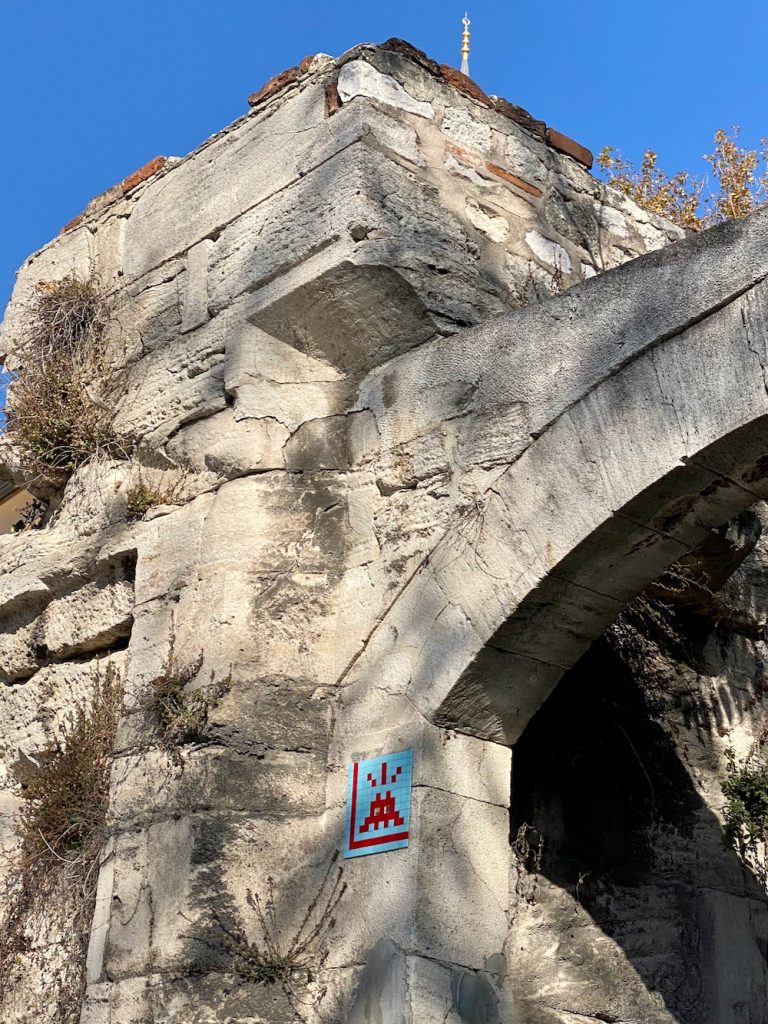 As I’ve written before, I love to wander in unfamiliar places—for me, the sense of discovery is worth the risk of missing something. For example, we walked into Sultan Ahmet Tomb with no foreknowledge of the splendor inside.
As I’ve written before, I love to wander in unfamiliar places—for me, the sense of discovery is worth the risk of missing something. For example, we walked into Sultan Ahmet Tomb with no foreknowledge of the splendor inside.
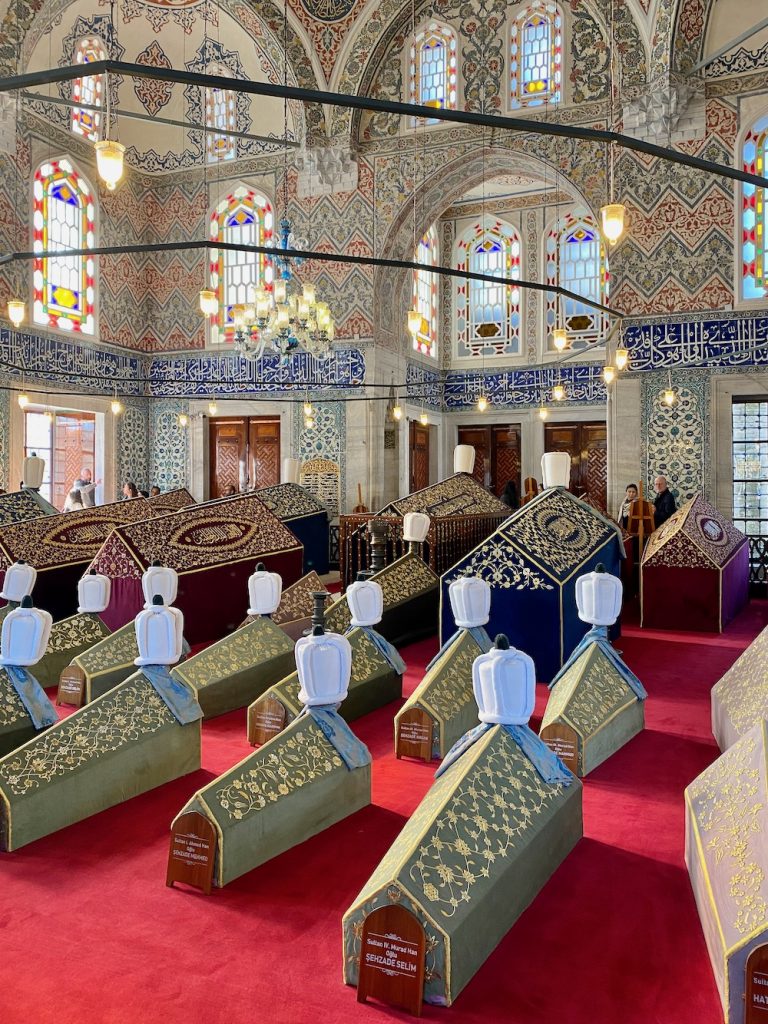
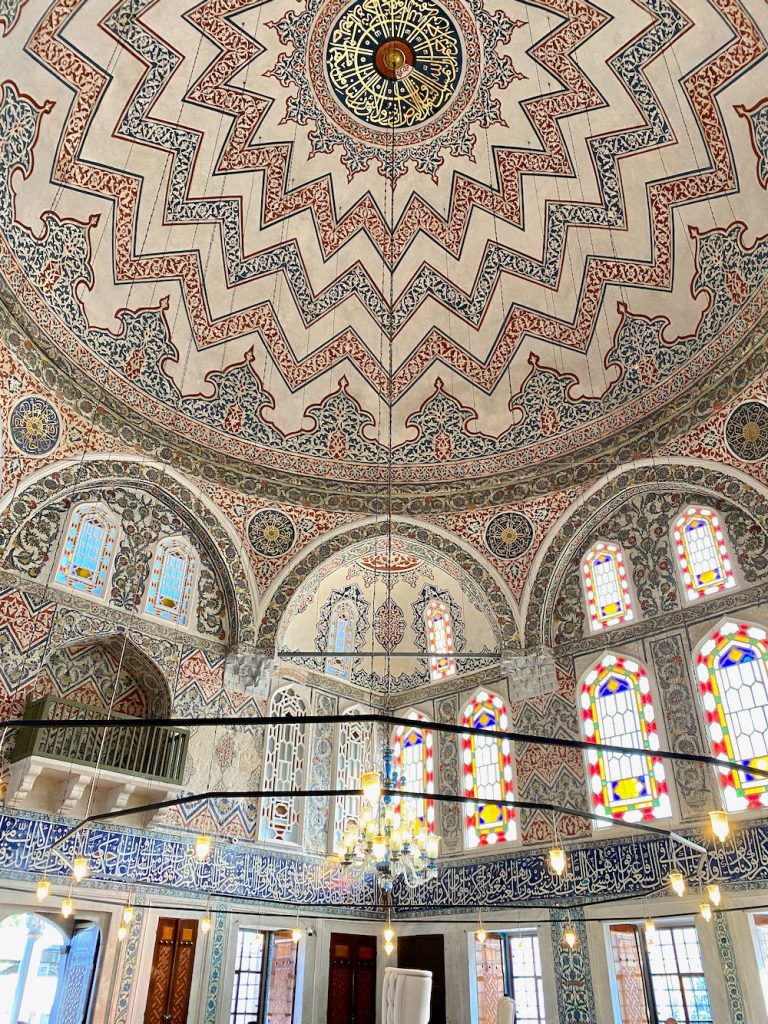
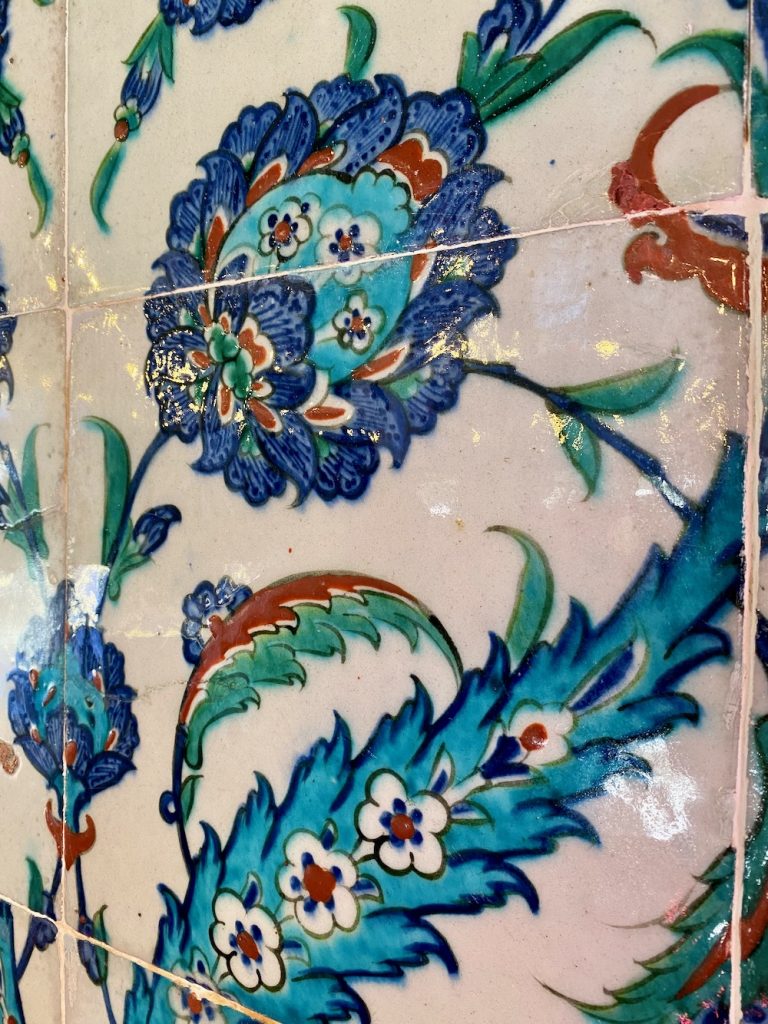 Same with Nuruosmaniye Mosque, which was all the more exquisite because no one else was there.
Same with Nuruosmaniye Mosque, which was all the more exquisite because no one else was there.
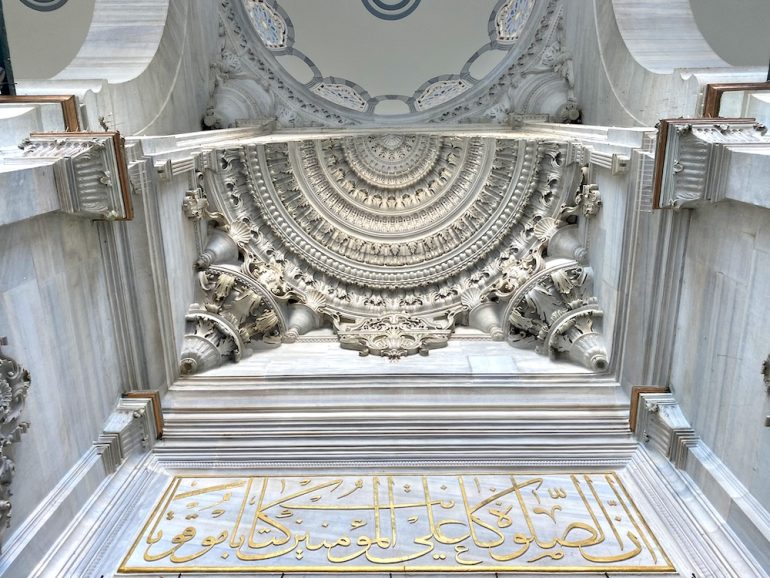
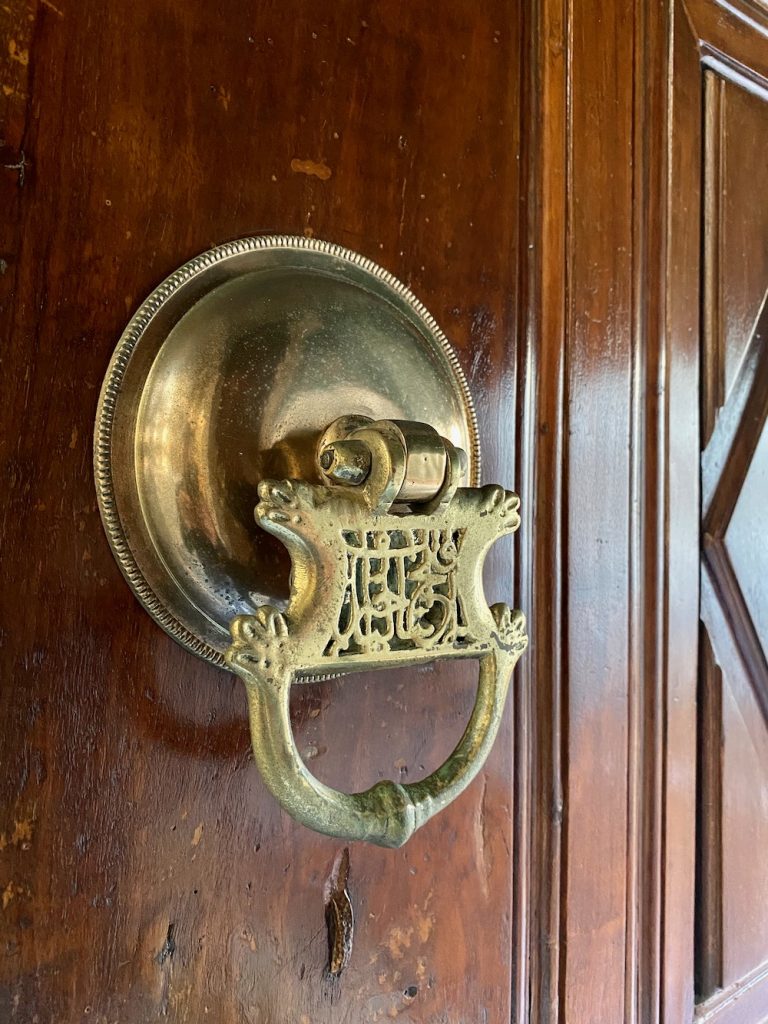
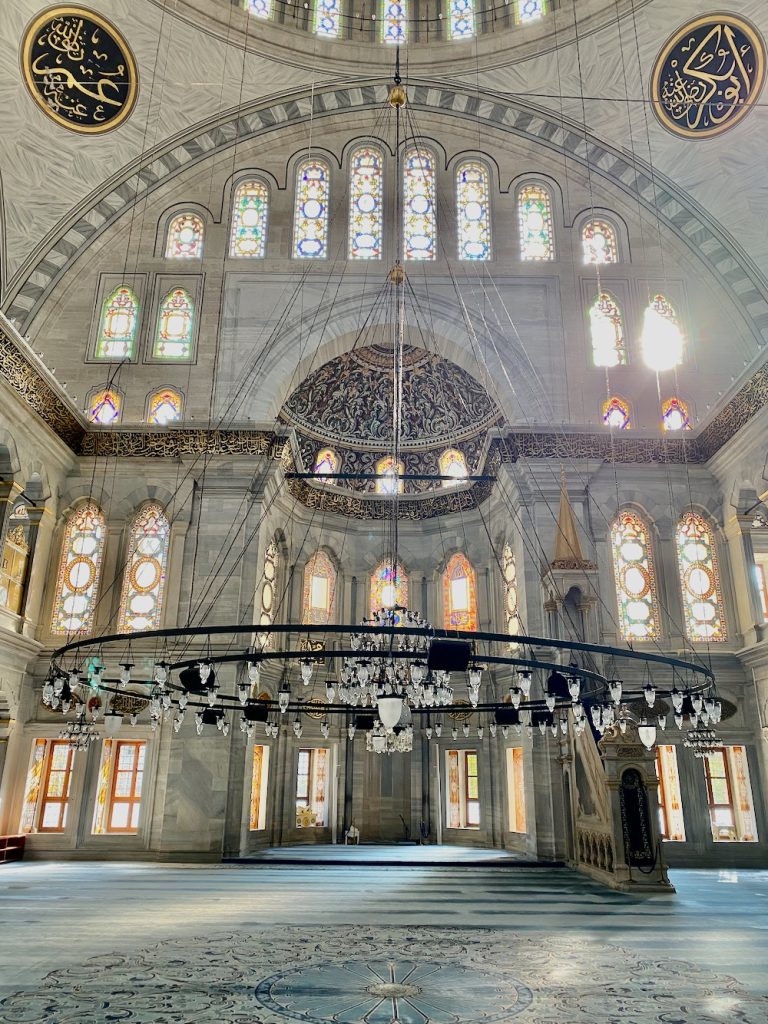 The conventional wisdom is that every first-timer in Istanbul should take a sunset cruise, and I won’t disagree, even though I’m wary of any tour I can’t leave at will. We chose Velena Travel‘s cruise because it included neither dinner nor show, just an occasional explanation from the tour guide.
The conventional wisdom is that every first-timer in Istanbul should take a sunset cruise, and I won’t disagree, even though I’m wary of any tour I can’t leave at will. We chose Velena Travel‘s cruise because it included neither dinner nor show, just an occasional explanation from the tour guide.
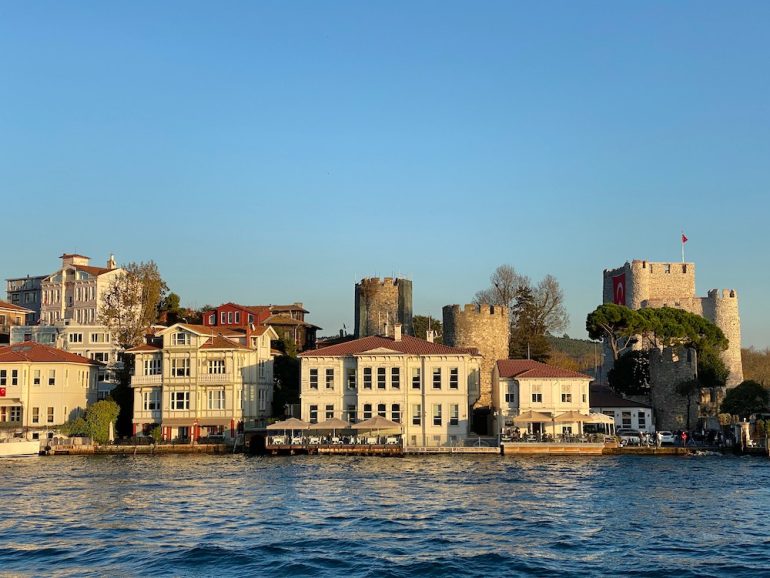

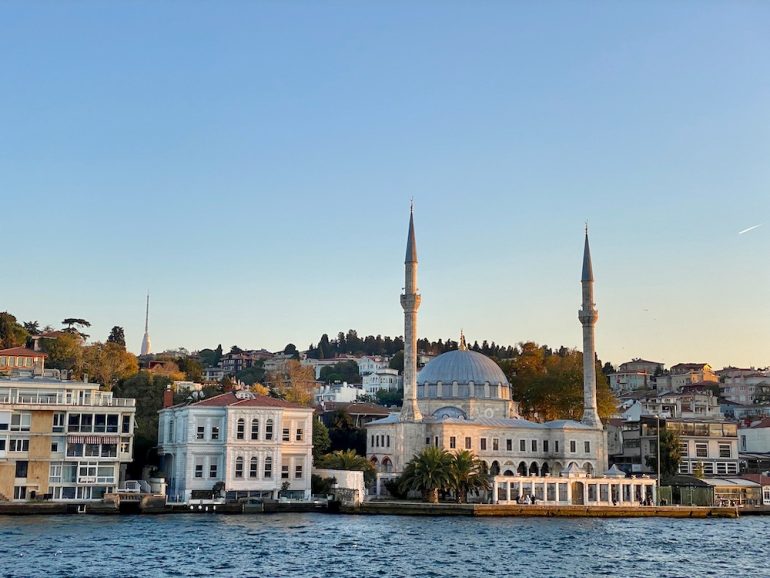
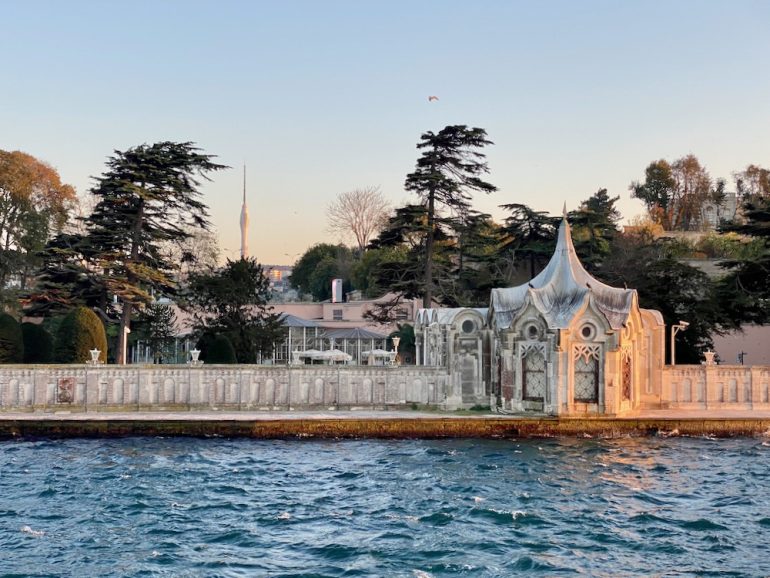
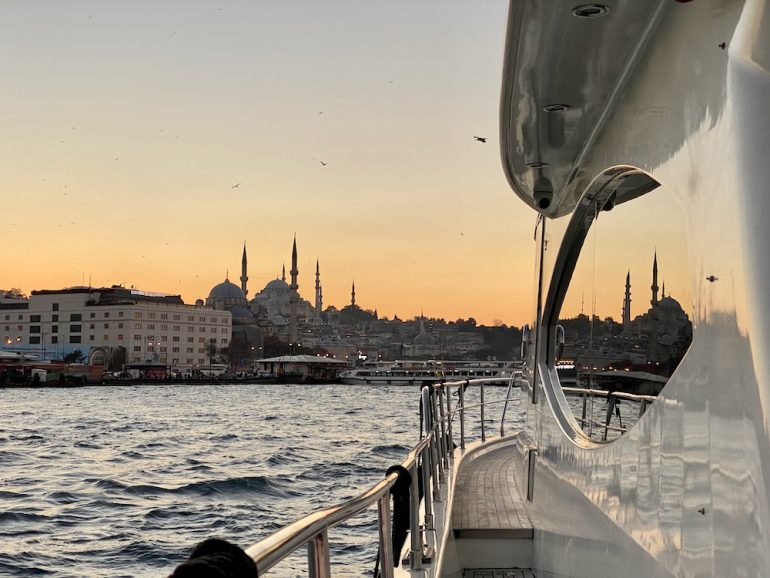 Van transfers were part of the deal, but I would advise planning your day so that you have reason to be in the embarkation area before and/or after the cruise, the better to minimize your time in traffic. And as we all know, you discover more while walking. The first photo below is the Galata Bridge linking the touristy and less-touristy parts of the city. And the second photo is of the Camondo Stairs, near Neolokal, the restaurant we went to the first night. They were a magical surprise.
Van transfers were part of the deal, but I would advise planning your day so that you have reason to be in the embarkation area before and/or after the cruise, the better to minimize your time in traffic. And as we all know, you discover more while walking. The first photo below is the Galata Bridge linking the touristy and less-touristy parts of the city. And the second photo is of the Camondo Stairs, near Neolokal, the restaurant we went to the first night. They were a magical surprise.
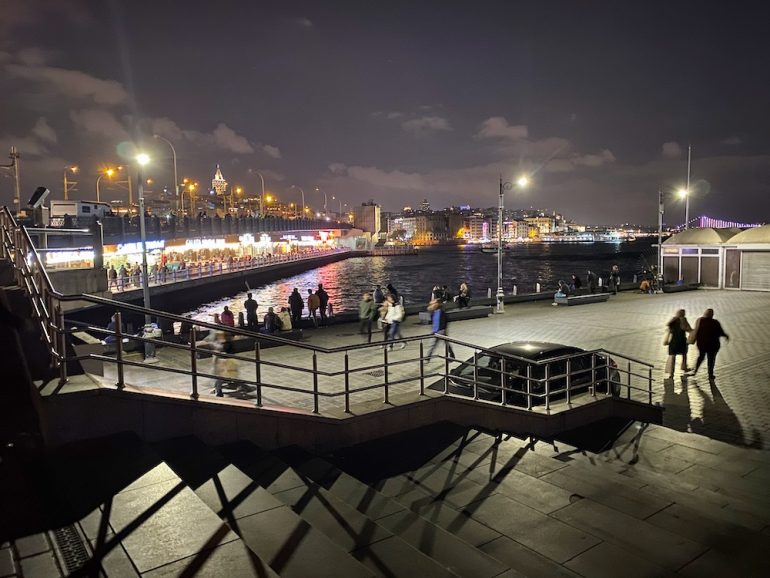
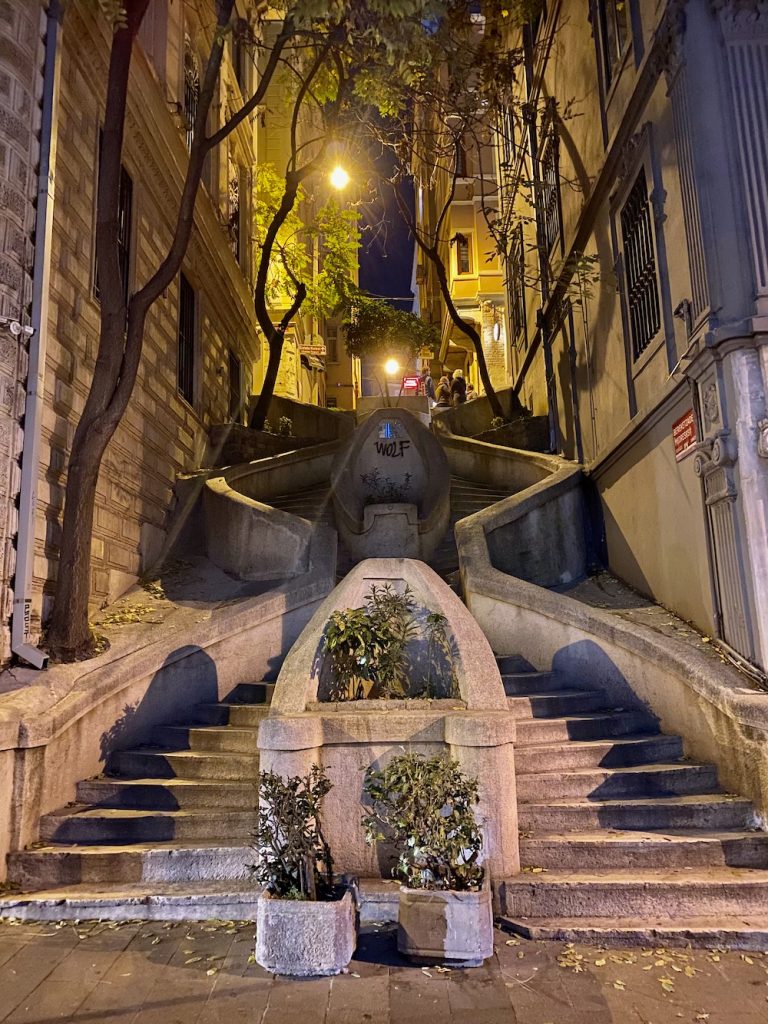 A huge benefit of staying in Sultanahmet is that we had reason to be in the area at night, when few other people were around.
A huge benefit of staying in Sultanahmet is that we had reason to be in the area at night, when few other people were around.
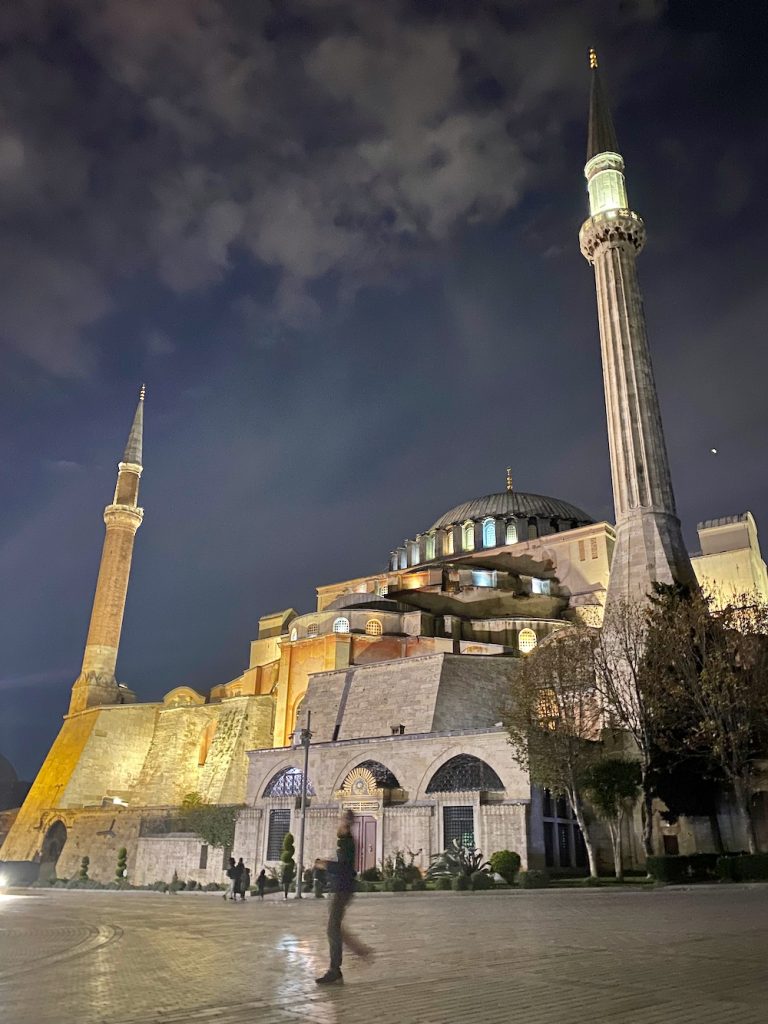
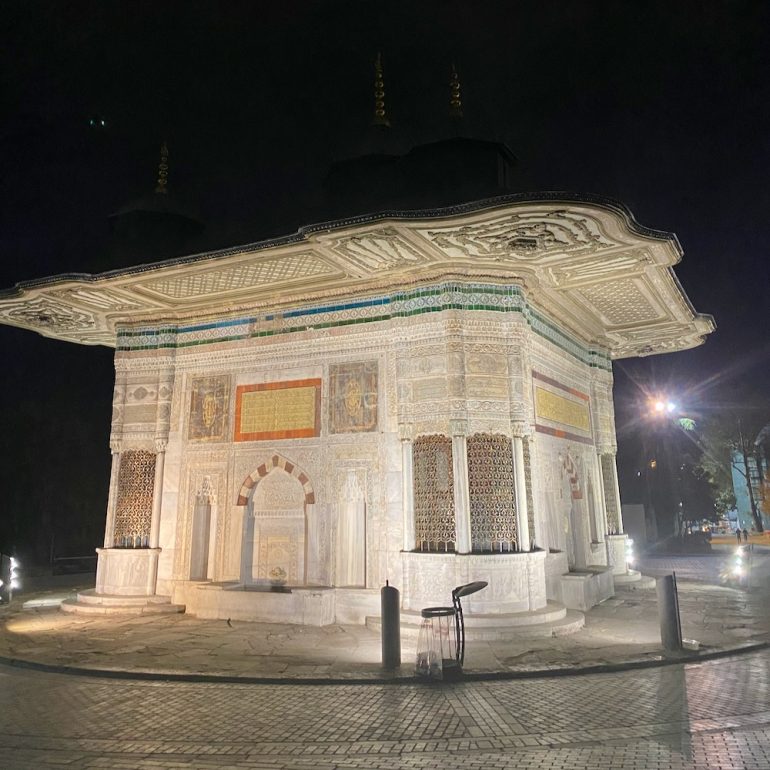 We hired a guide for the second day, not only for her knowledge but because with a licensed guide, you get to skip the long ticket lines at certain attractions. (Security lines are another matter.) Unfortunately, you will also probably be taken to a rug shop; I kicked myself for not just offering her more money in advance to avoid the experience. The Hagia Sofia, a mosque that was once a church, is spectacular, although all the people standing around on broad, carpeted floors gave the impression of a hotel ballroom.
We hired a guide for the second day, not only for her knowledge but because with a licensed guide, you get to skip the long ticket lines at certain attractions. (Security lines are another matter.) Unfortunately, you will also probably be taken to a rug shop; I kicked myself for not just offering her more money in advance to avoid the experience. The Hagia Sofia, a mosque that was once a church, is spectacular, although all the people standing around on broad, carpeted floors gave the impression of a hotel ballroom.
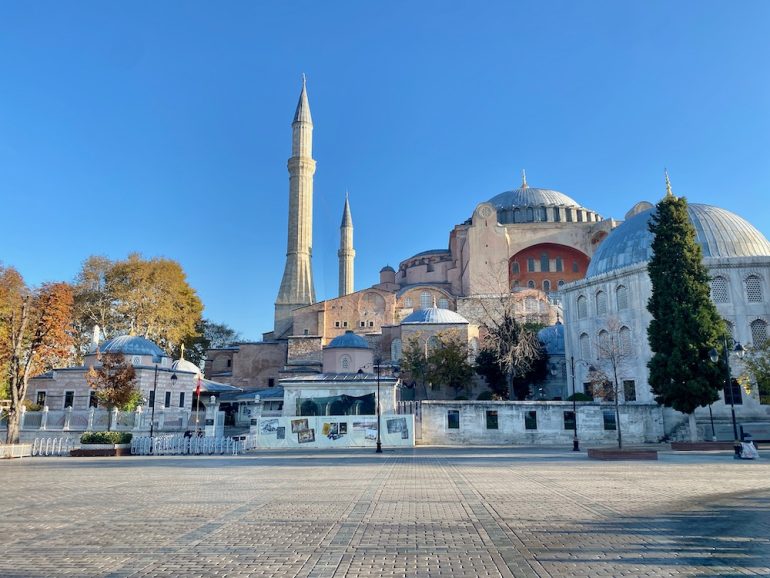
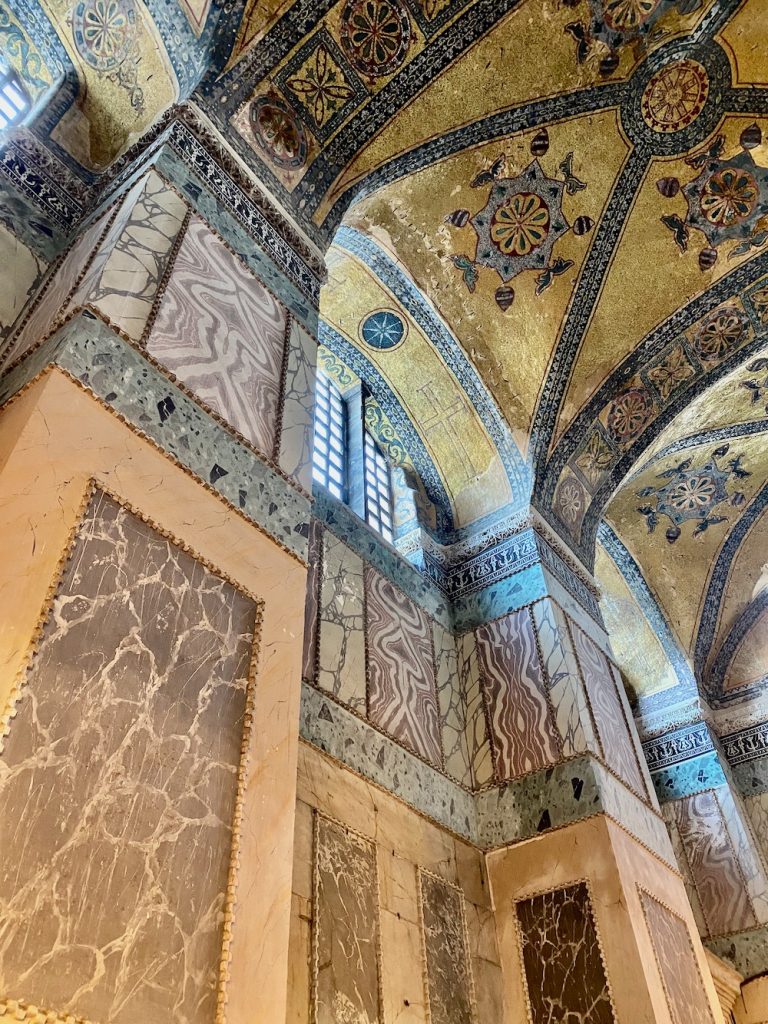
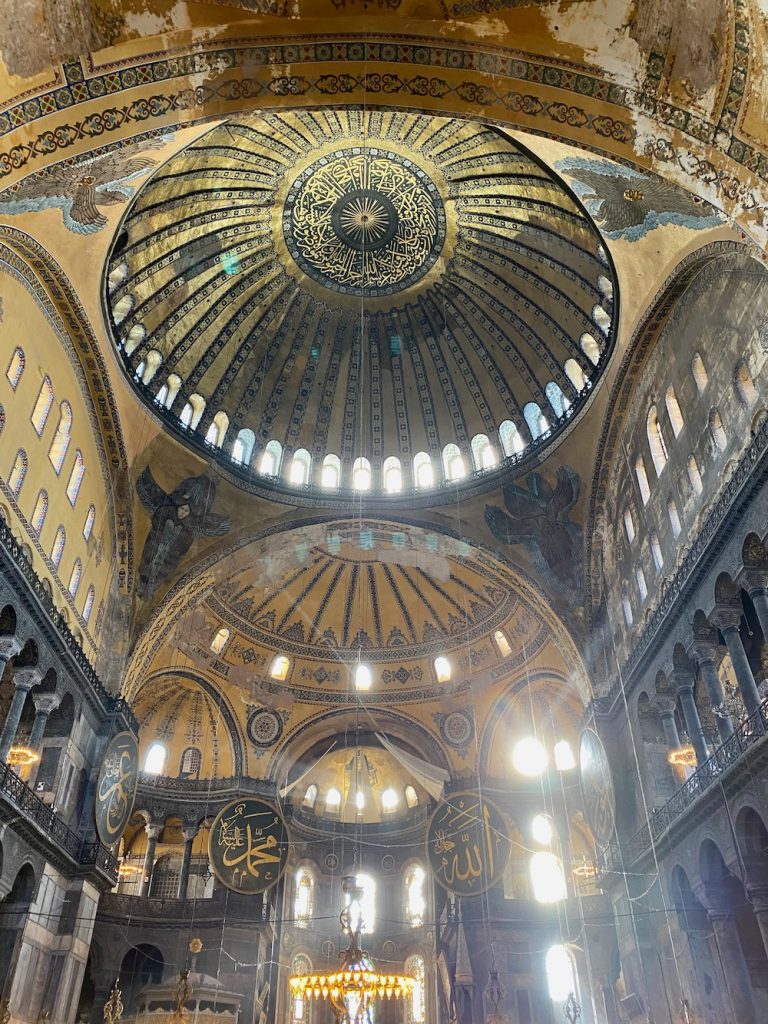
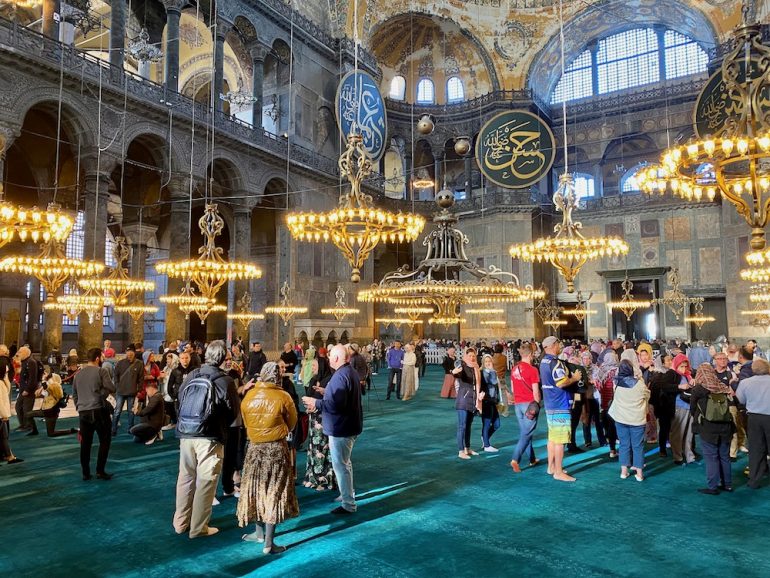 The next stop was an ornate cistern—they’re everywhere in the city—with a light show that the field-tripping schoolkids seemed to enjoy. Our guide said that when she was a child, there were no boardwalks over the water, and instead visitors rowed a boat around the room.
The next stop was an ornate cistern—they’re everywhere in the city—with a light show that the field-tripping schoolkids seemed to enjoy. Our guide said that when she was a child, there were no boardwalks over the water, and instead visitors rowed a boat around the room.
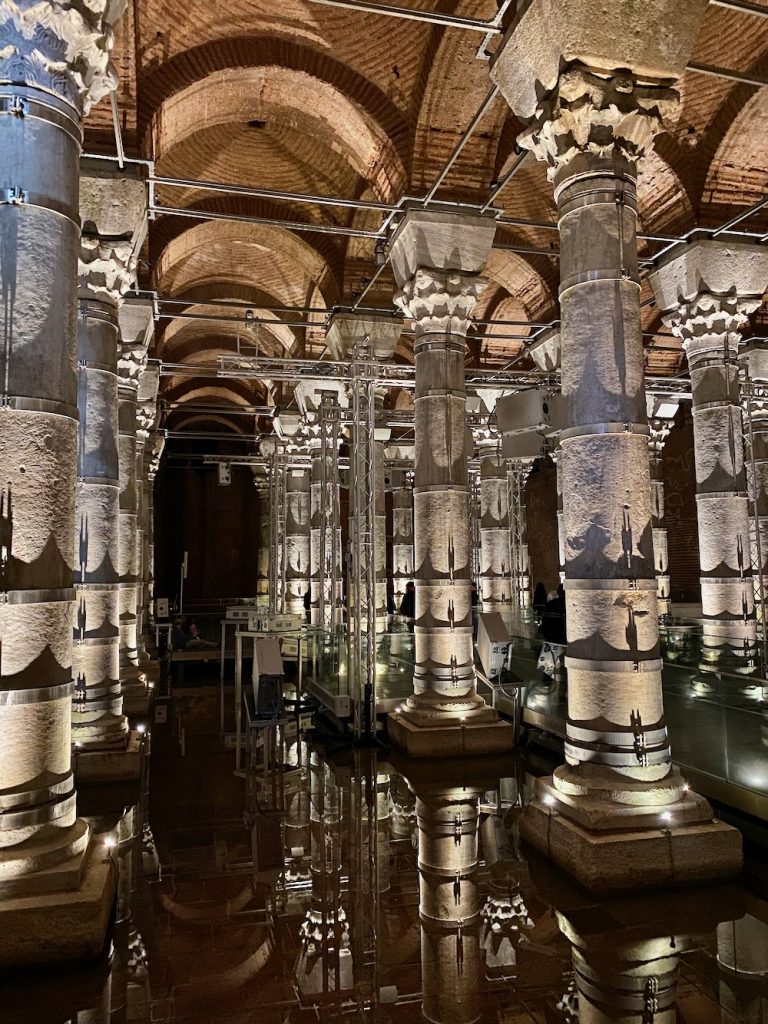 After the carpet shop, where at least there was a kitten, we went to Topkapi Palace: it has marvelous buildings and lots of exhibits of old stuff, which isn’t really my thing (except for the squiggly sword). And there were a lot of people there, despite how the palace appears in my photos.
After the carpet shop, where at least there was a kitten, we went to Topkapi Palace: it has marvelous buildings and lots of exhibits of old stuff, which isn’t really my thing (except for the squiggly sword). And there were a lot of people there, despite how the palace appears in my photos.
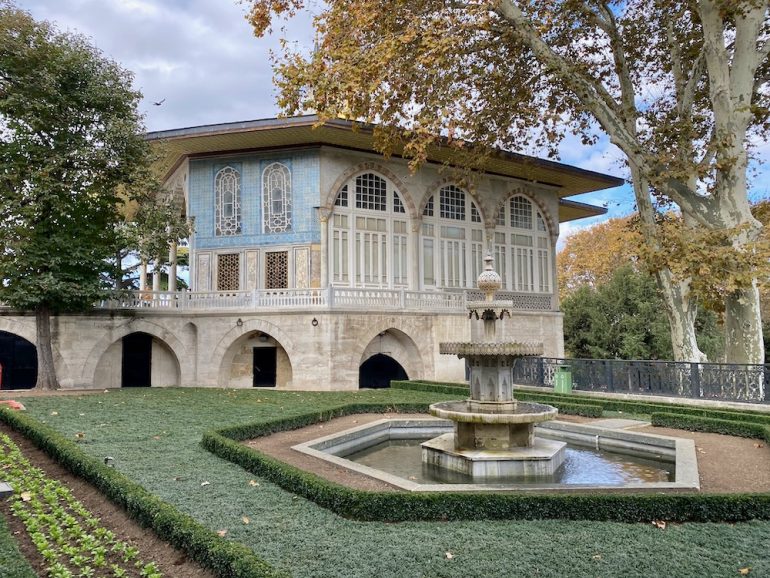
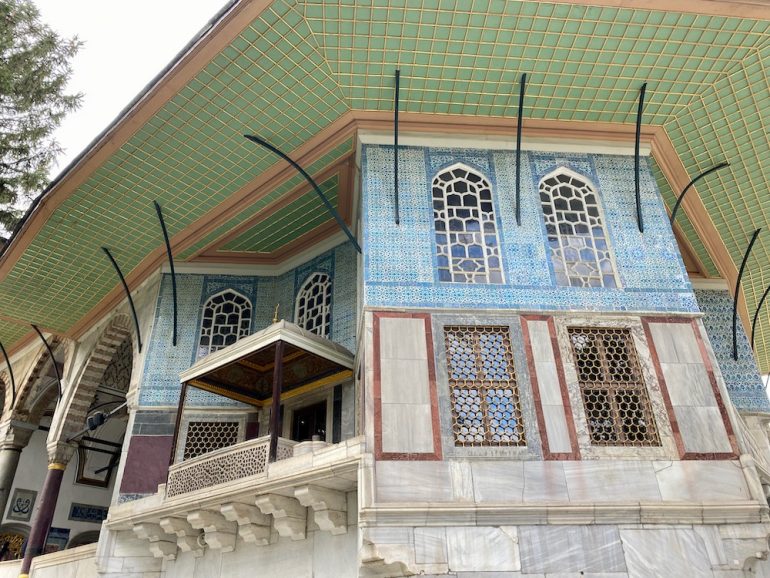
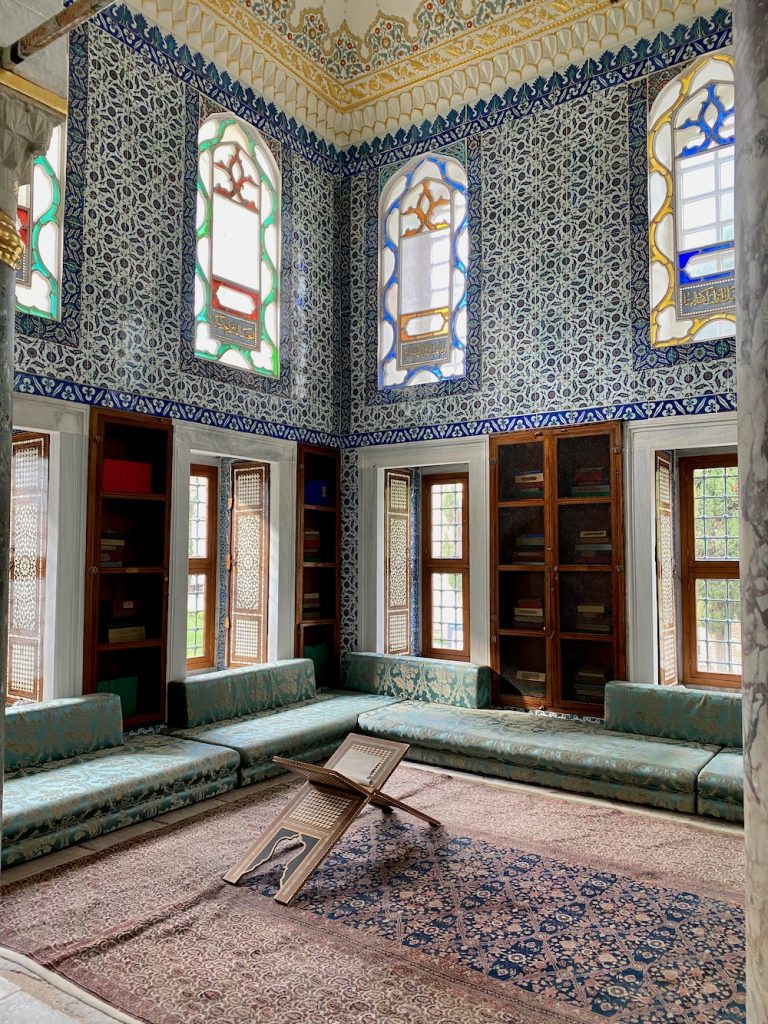
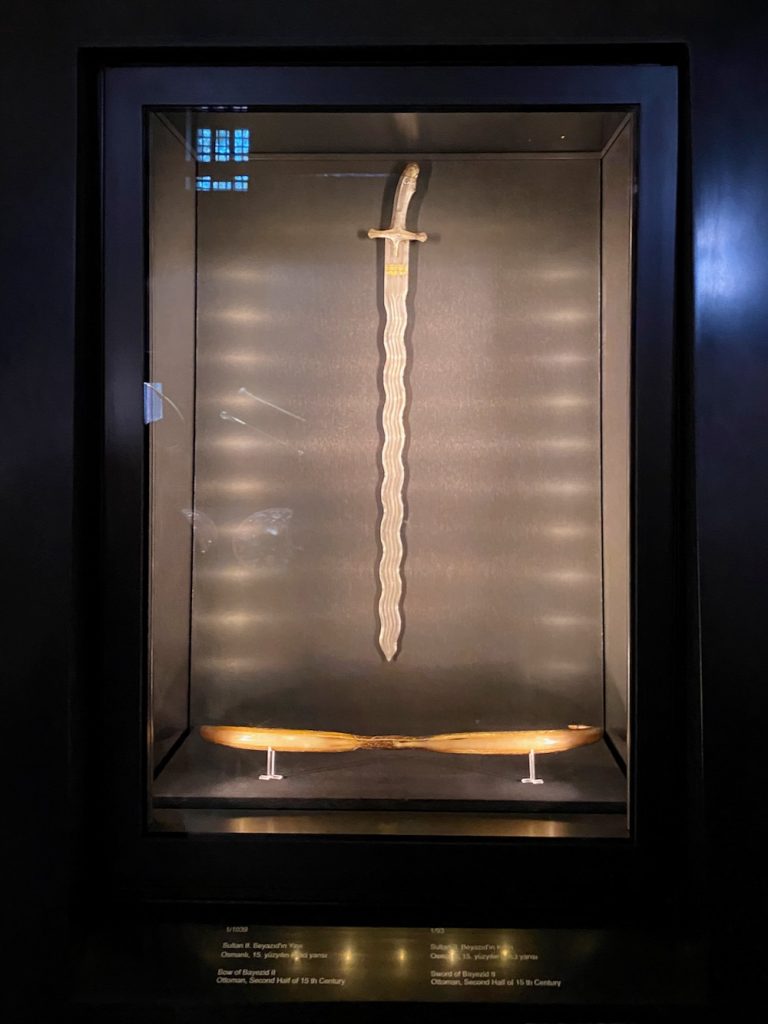 There were even more people at the spice market, which struck me as pretty touristy, with as many stalls selling souvenirs and counterfeit handbags as ones selling spices. (The Grand Bazaar, which we visited another day, was less touristy but much more overwhelming.) More my speed was the Rustem Pasha mosque nearby. The walls of the Blue Mosque were under renovation during our visit, and our guide said that Rustem Pasha’s are equivalent.
There were even more people at the spice market, which struck me as pretty touristy, with as many stalls selling souvenirs and counterfeit handbags as ones selling spices. (The Grand Bazaar, which we visited another day, was less touristy but much more overwhelming.) More my speed was the Rustem Pasha mosque nearby. The walls of the Blue Mosque were under renovation during our visit, and our guide said that Rustem Pasha’s are equivalent.
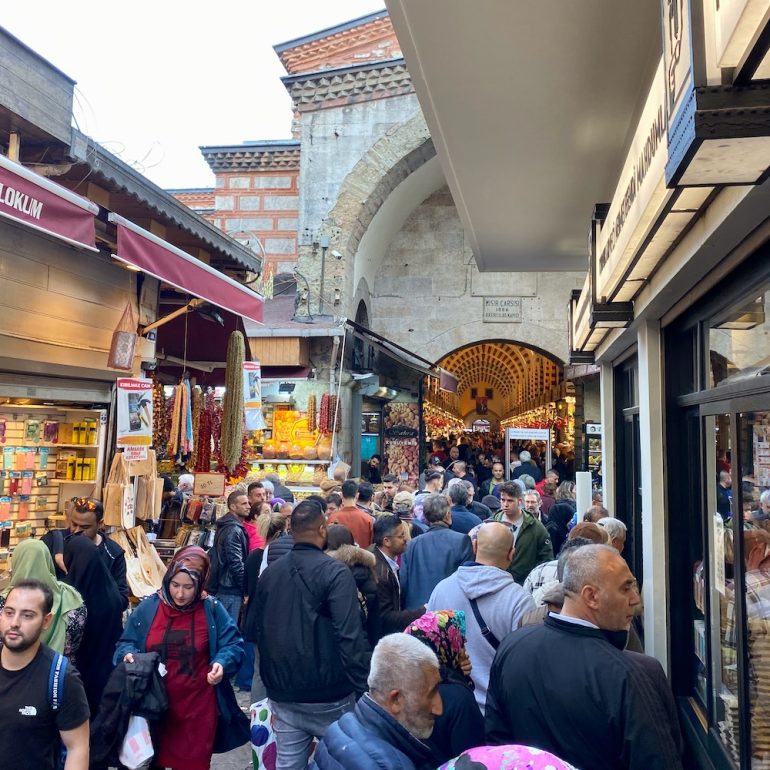
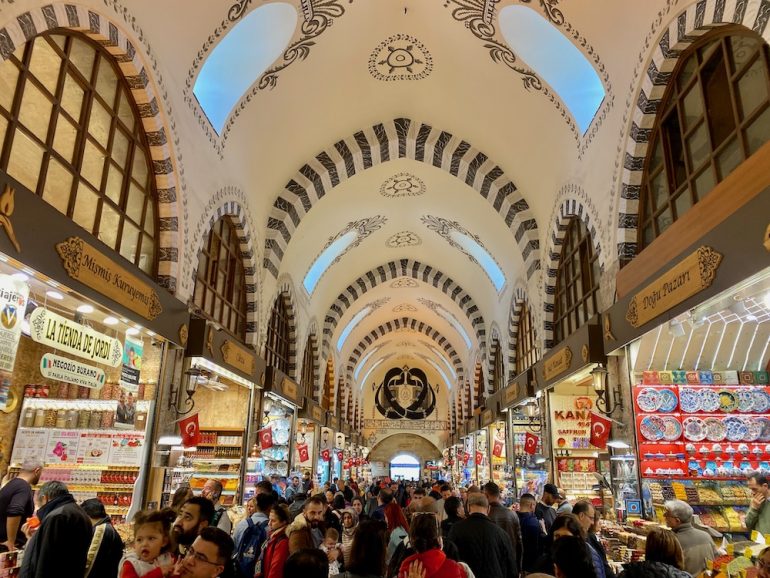
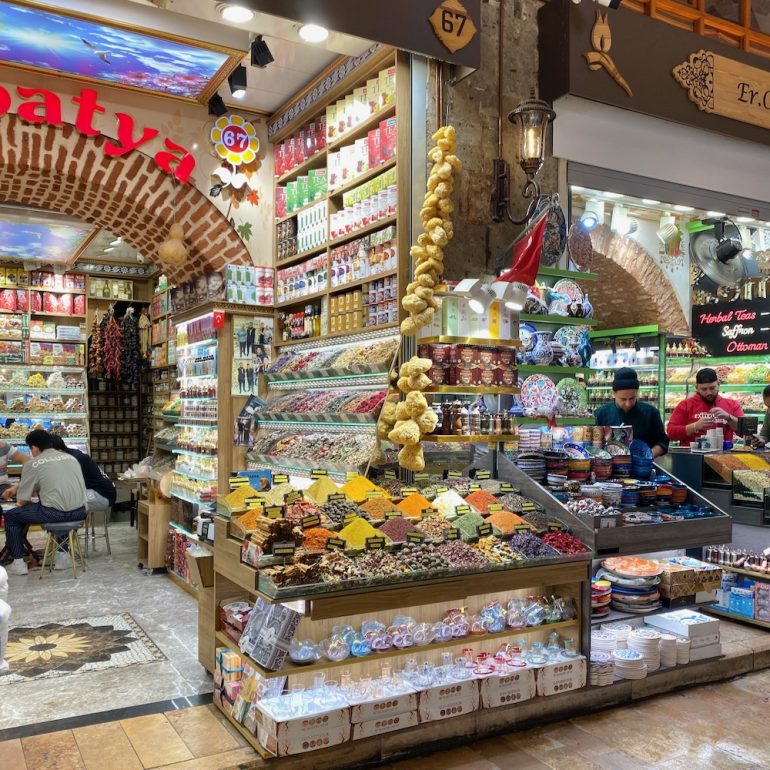
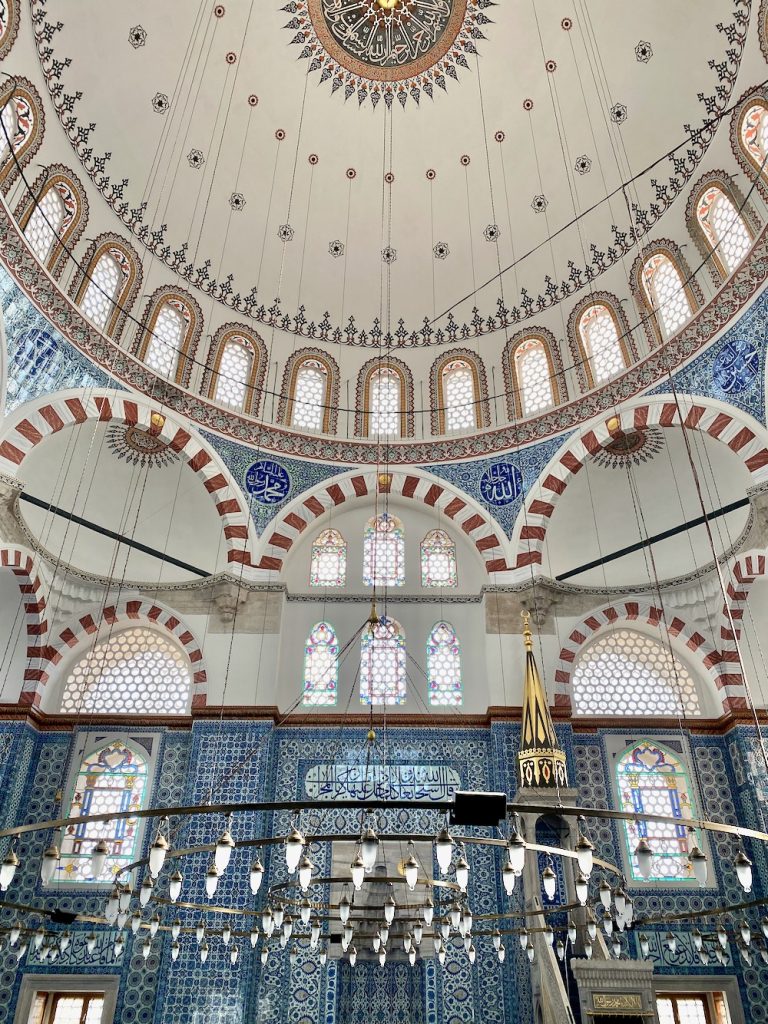 After all that slow shuffling you have to do in crowds of tourists, I was thrilled to explore the neighborhoods across the Bosphorus. We logged 35,000 steps in one day, which must be a personal best. Here are a bunch of street scenes from various parts of the city, to give a sense of what it’s like.
After all that slow shuffling you have to do in crowds of tourists, I was thrilled to explore the neighborhoods across the Bosphorus. We logged 35,000 steps in one day, which must be a personal best. Here are a bunch of street scenes from various parts of the city, to give a sense of what it’s like.
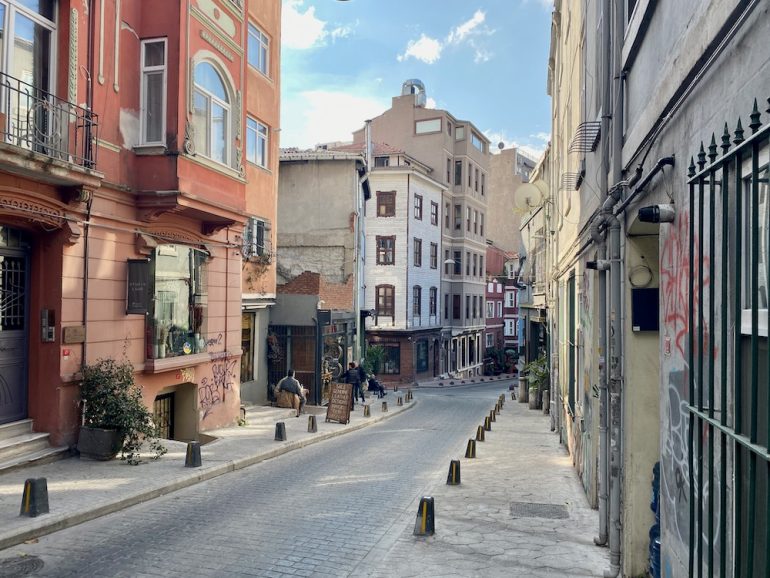
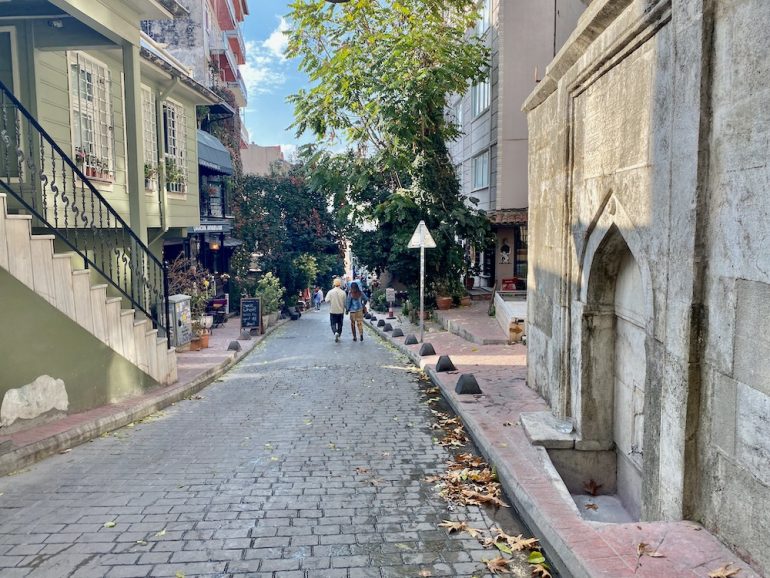
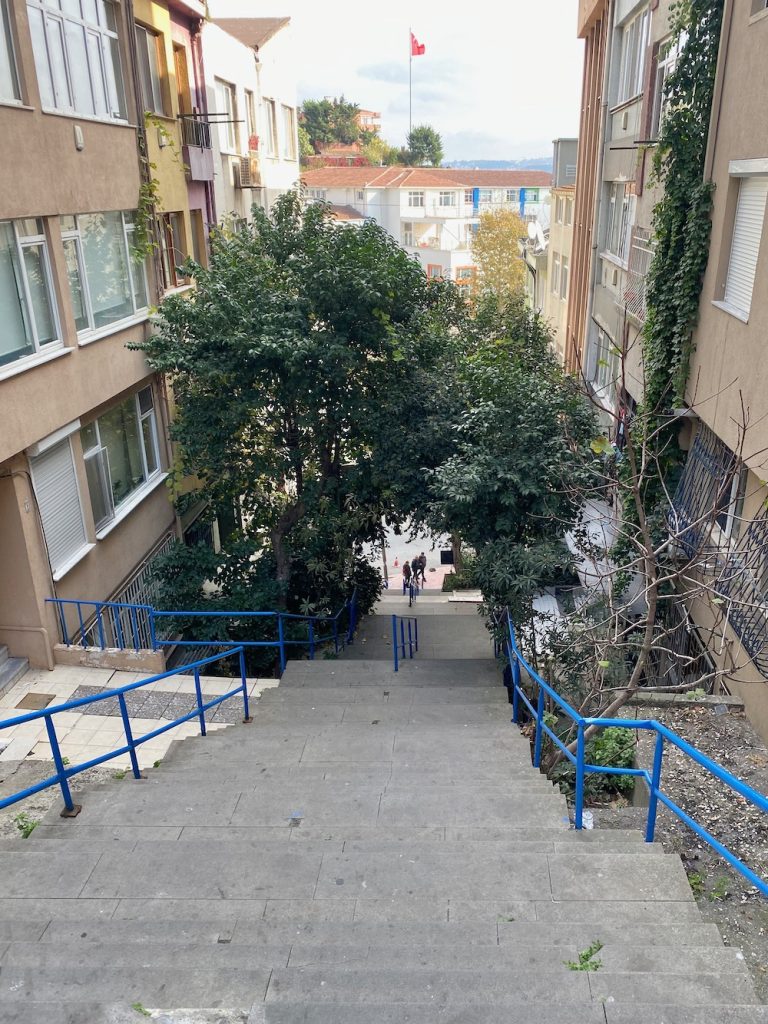
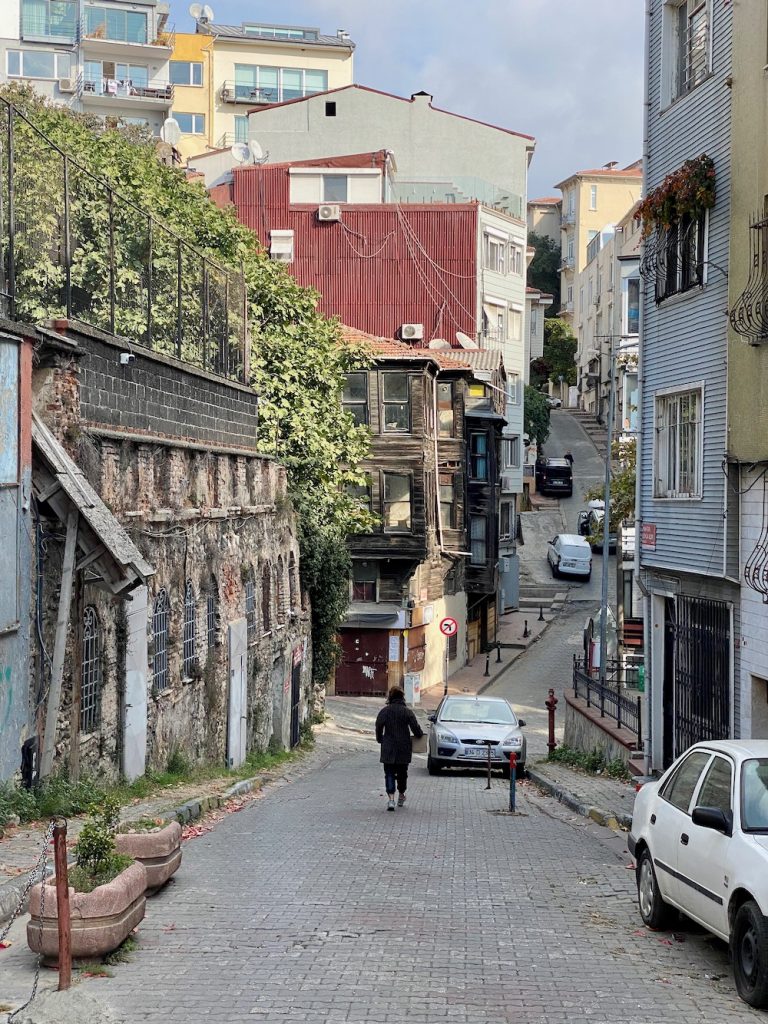
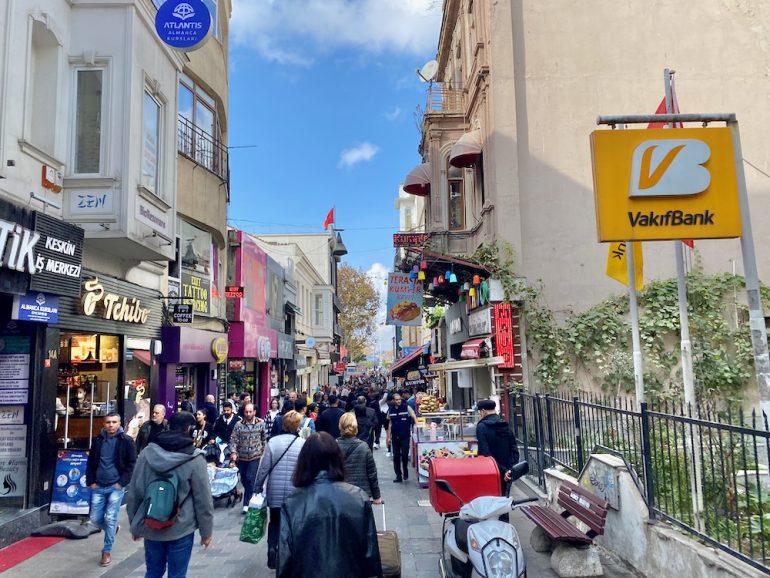
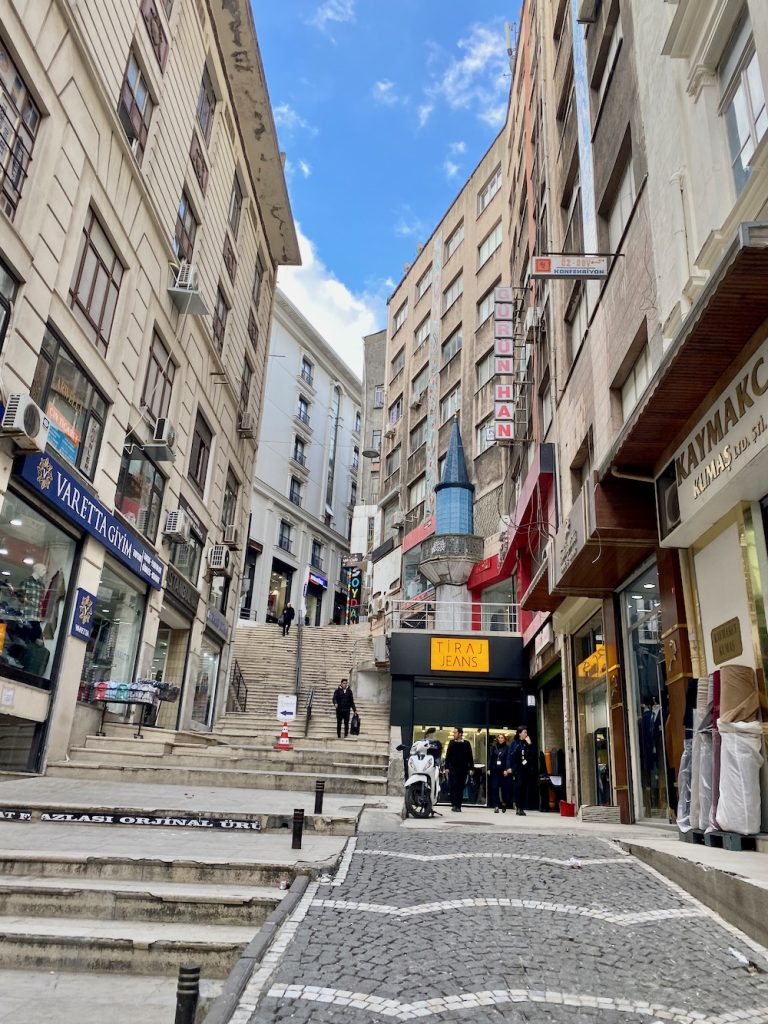
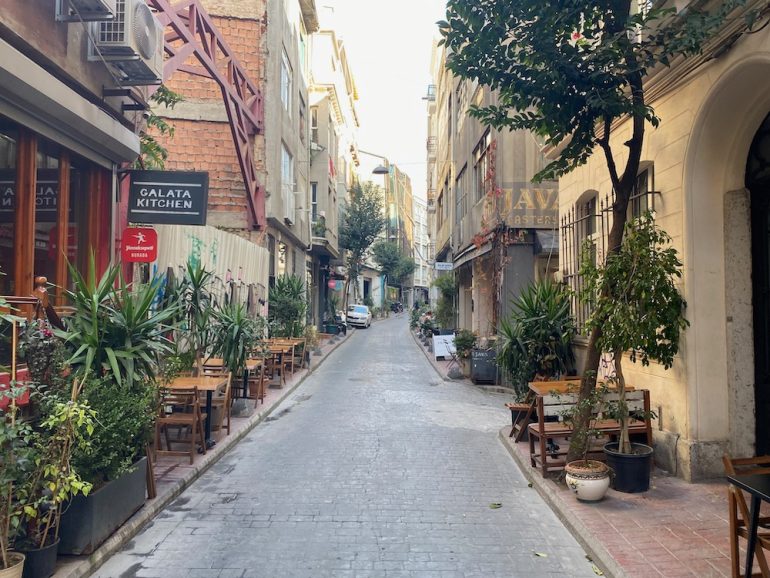 The architecture was often remarkable; in particular, there are still many old wooden buildings that reminded me of Estonia (though I’ve never been), Scandinavia, and the Pacific Northwest.
The architecture was often remarkable; in particular, there are still many old wooden buildings that reminded me of Estonia (though I’ve never been), Scandinavia, and the Pacific Northwest.
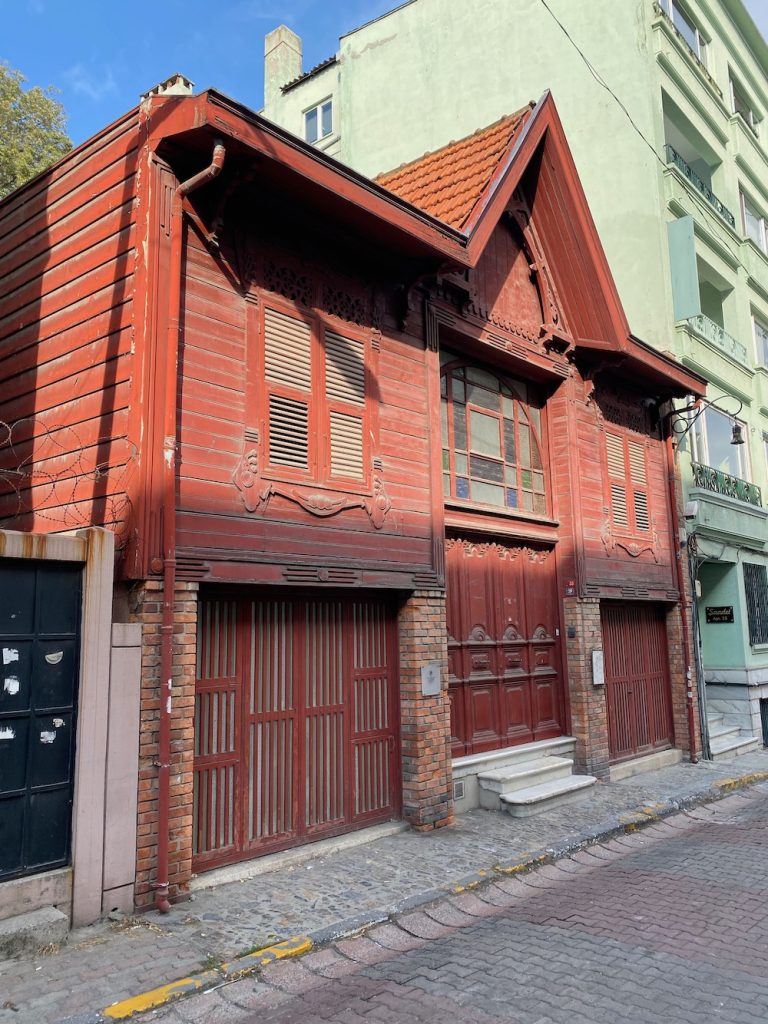
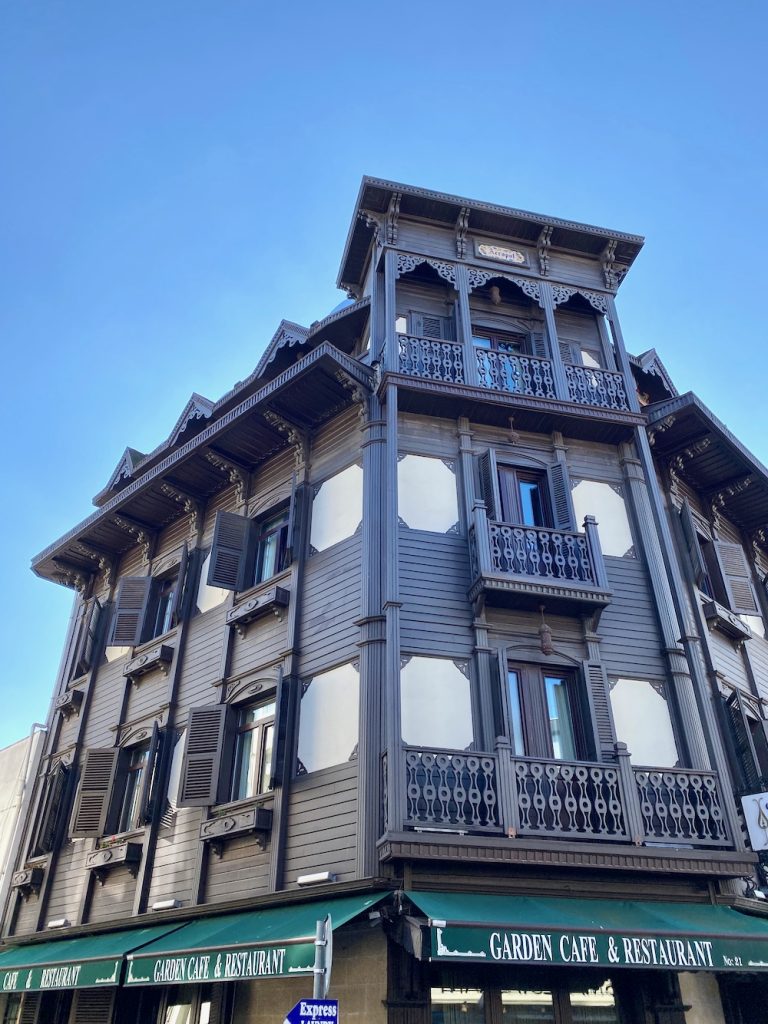
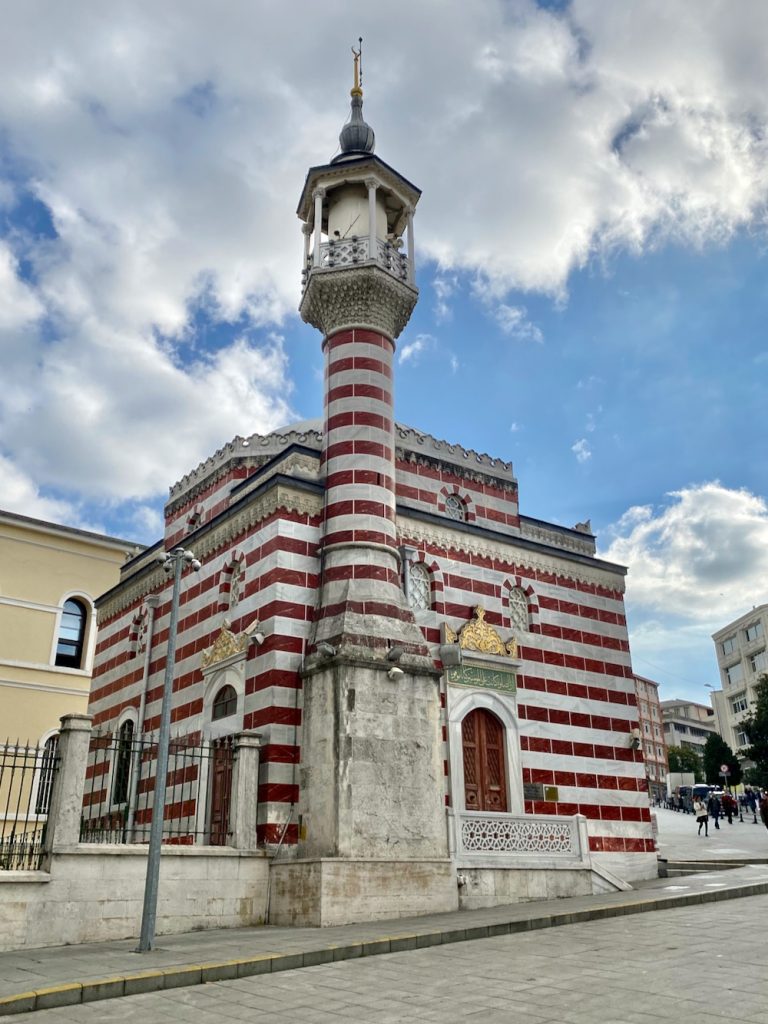
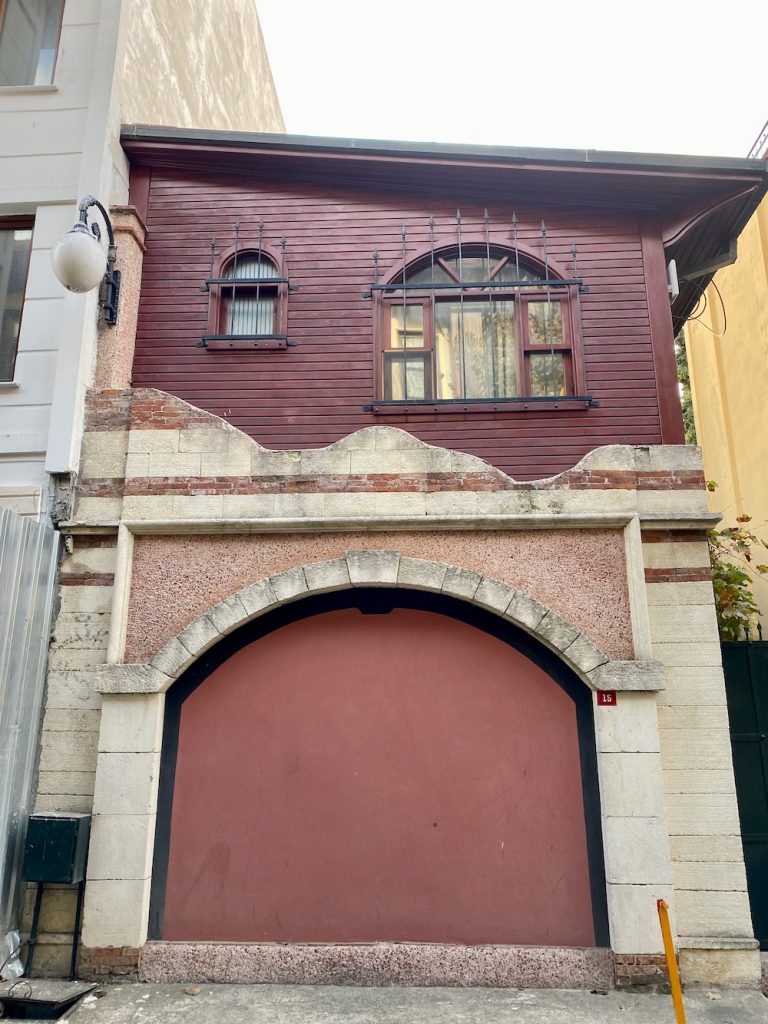
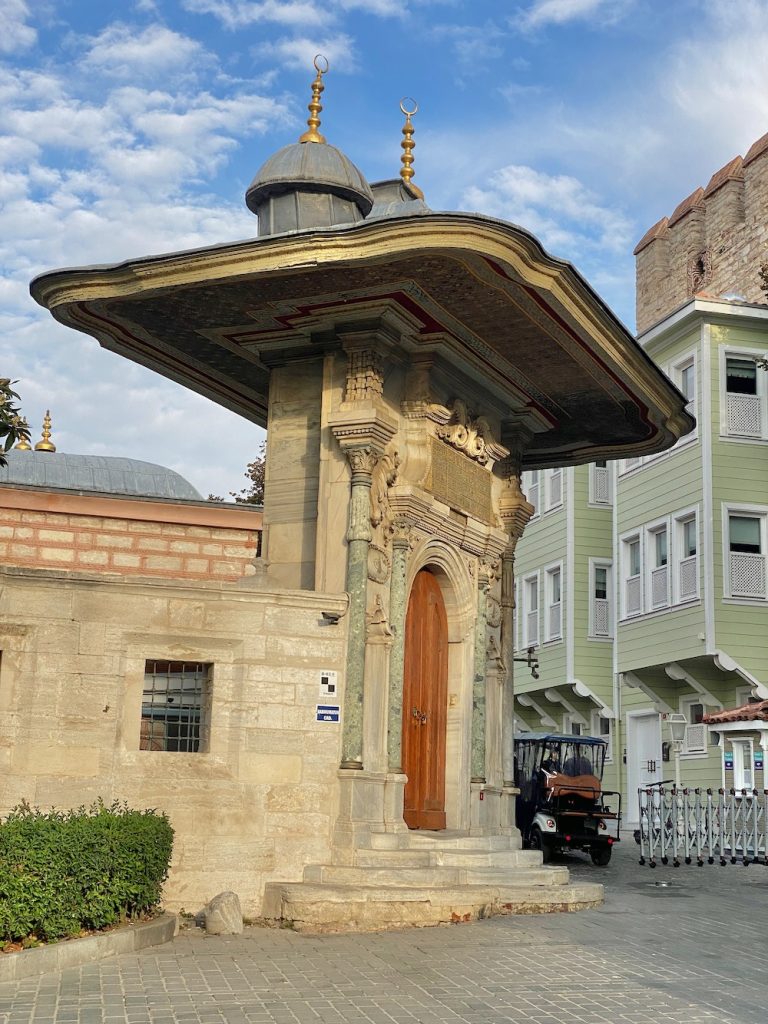 Galata Tower proved to be more interesting that we expected—the views are great, of course, but what we’ll remember most is the narrow staircase you take back down.
Galata Tower proved to be more interesting that we expected—the views are great, of course, but what we’ll remember most is the narrow staircase you take back down.
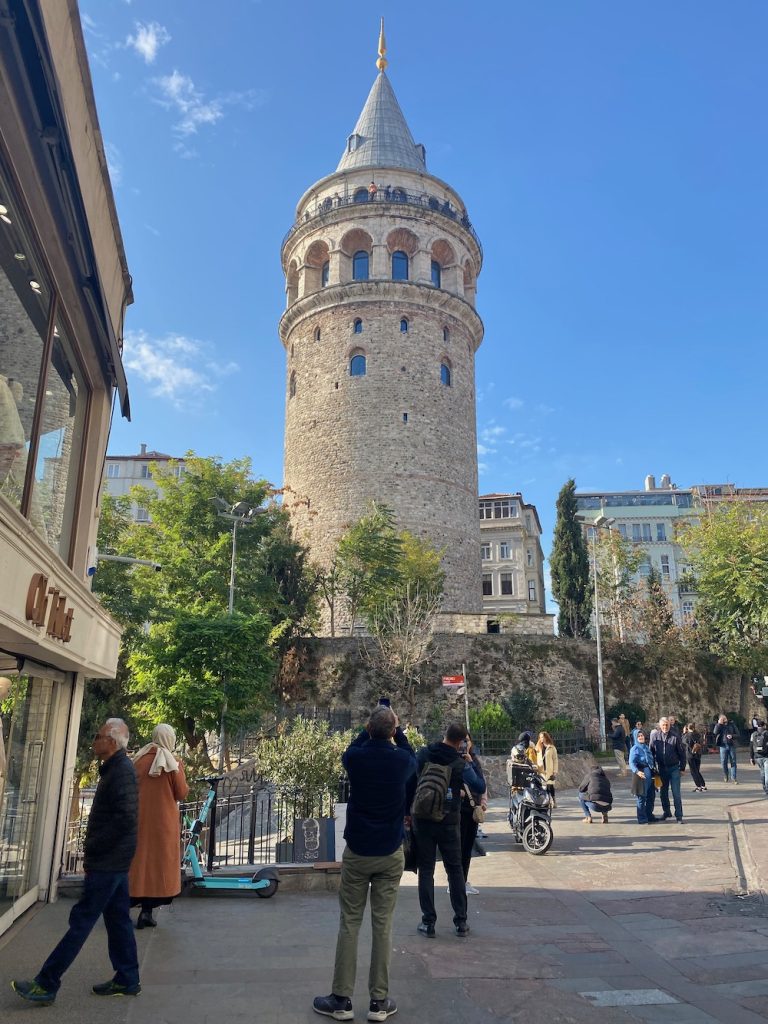
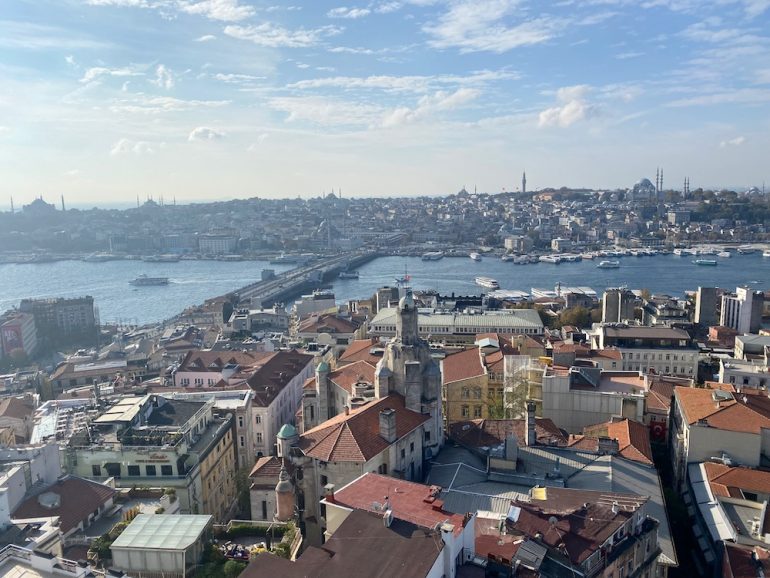
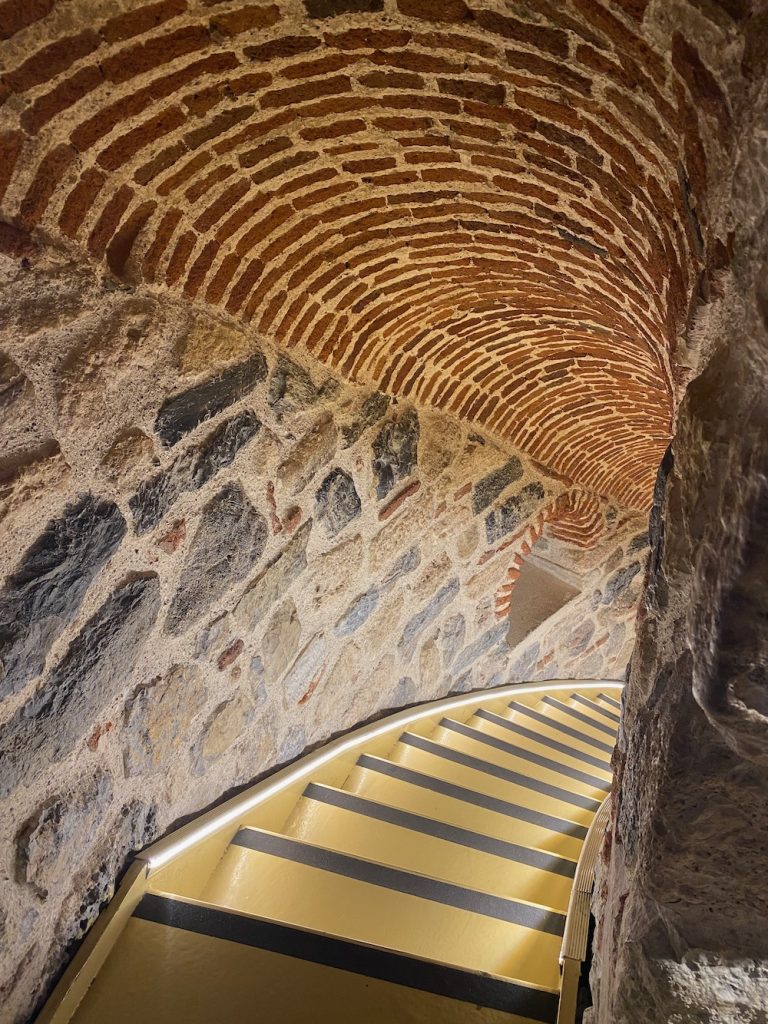 Dolmabahçe Palace, however, was a slog: while the exterior is obviously stunning, you explore the inside via a single-file, labyrinthine march during which you come upon room after room of chairs. It was a good example of the kind of tourism experience I hate because you can’t pull the ripcord. And while the food at the café wasn’t good, the setting was world-class.
Dolmabahçe Palace, however, was a slog: while the exterior is obviously stunning, you explore the inside via a single-file, labyrinthine march during which you come upon room after room of chairs. It was a good example of the kind of tourism experience I hate because you can’t pull the ripcord. And while the food at the café wasn’t good, the setting was world-class.
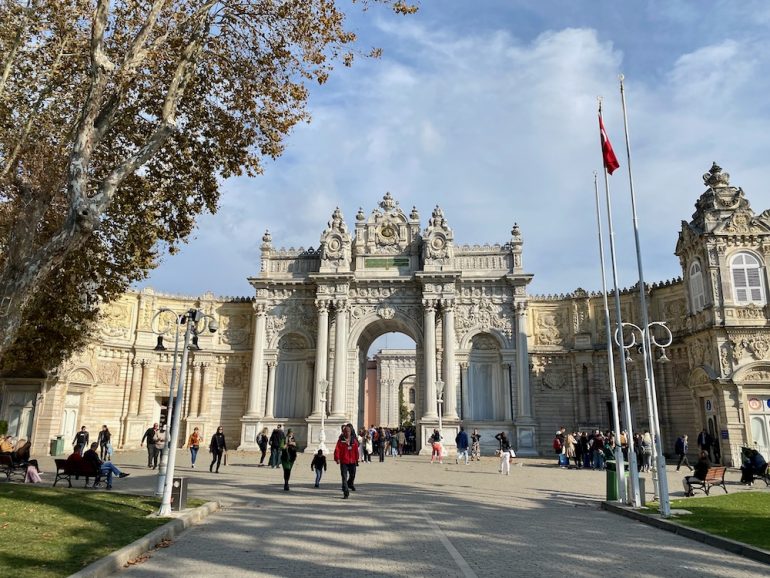
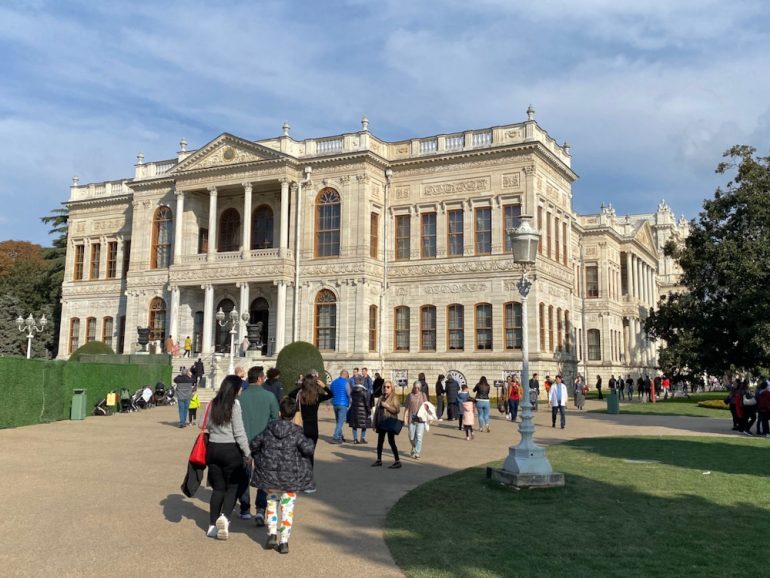
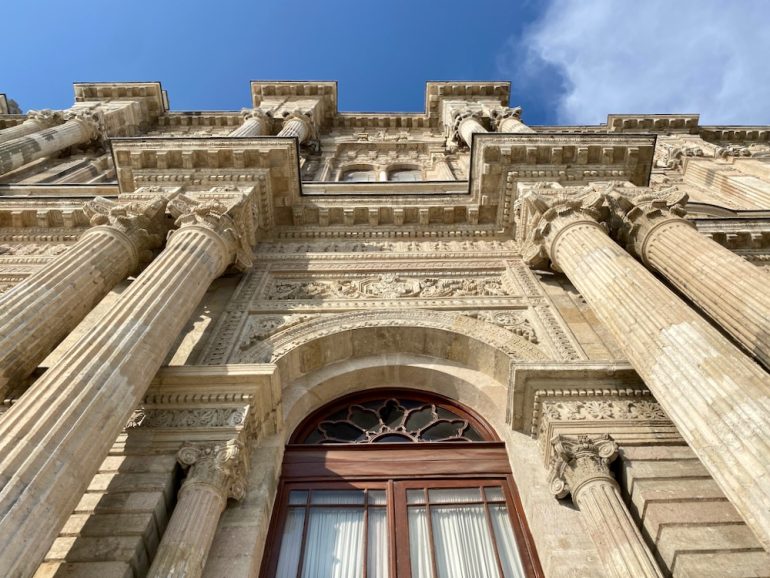
 I think I’ve only seen two Turkish movies in my life: one was Mustang, highly recommended but not relevant here, and the other was Stray, a documentary that followed dogs around Istanbul. Because of Stray, we knew that the Turkish government chooses to let stray animals be. So you’ll be walking around and a dog will just be lying there….
I think I’ve only seen two Turkish movies in my life: one was Mustang, highly recommended but not relevant here, and the other was Stray, a documentary that followed dogs around Istanbul. Because of Stray, we knew that the Turkish government chooses to let stray animals be. So you’ll be walking around and a dog will just be lying there….
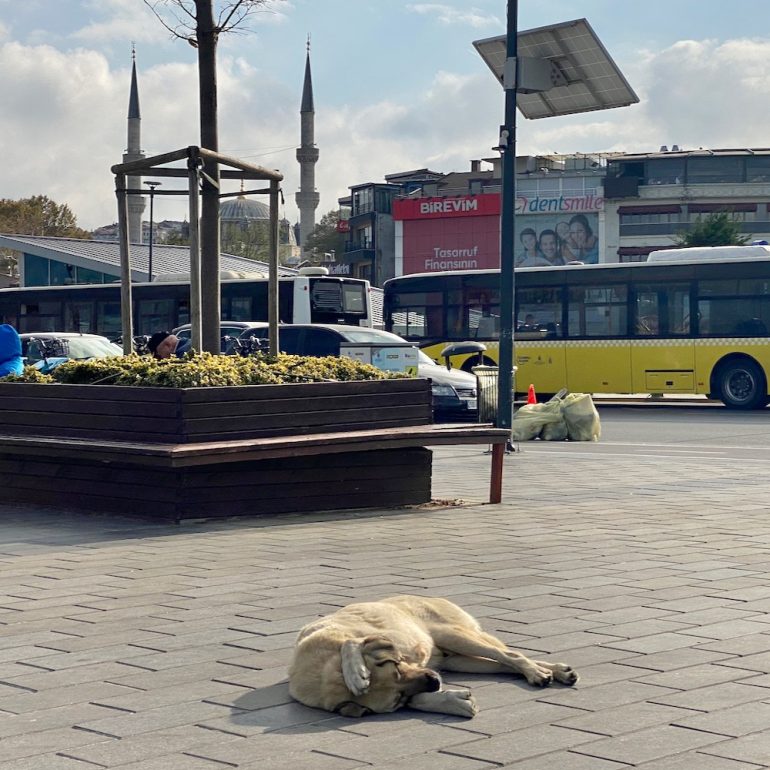 They seemed healthy and happy. One park had a vending machine that dumped out dog food.
They seemed healthy and happy. One park had a vending machine that dumped out dog food.
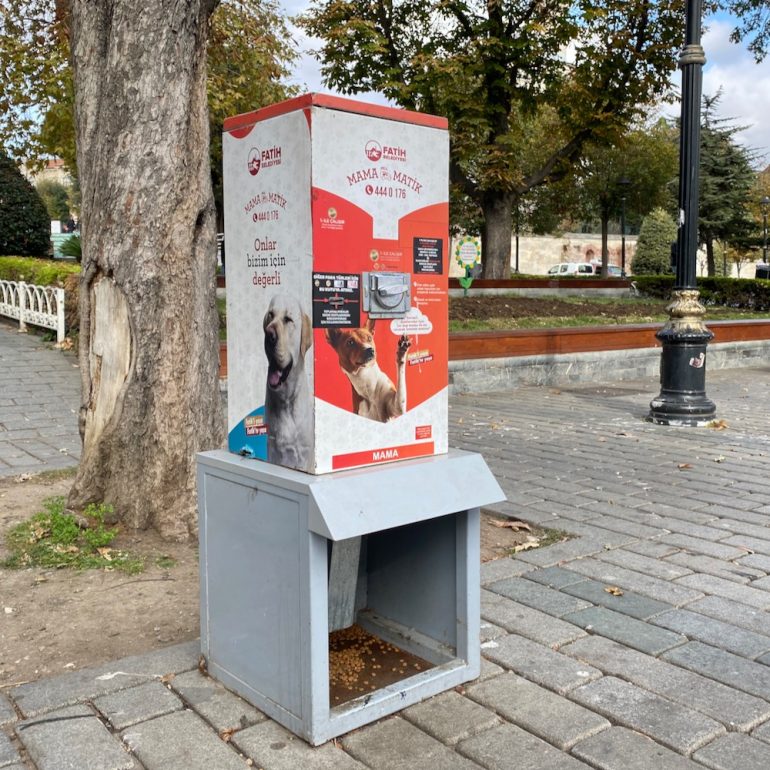 That said, the city is ruled by cats. They’re everywhere; they pay humans no mind; and they, too, seem well cared for. People leave out little shelters for them, as well as food on the sidewalk.
That said, the city is ruled by cats. They’re everywhere; they pay humans no mind; and they, too, seem well cared for. People leave out little shelters for them, as well as food on the sidewalk.
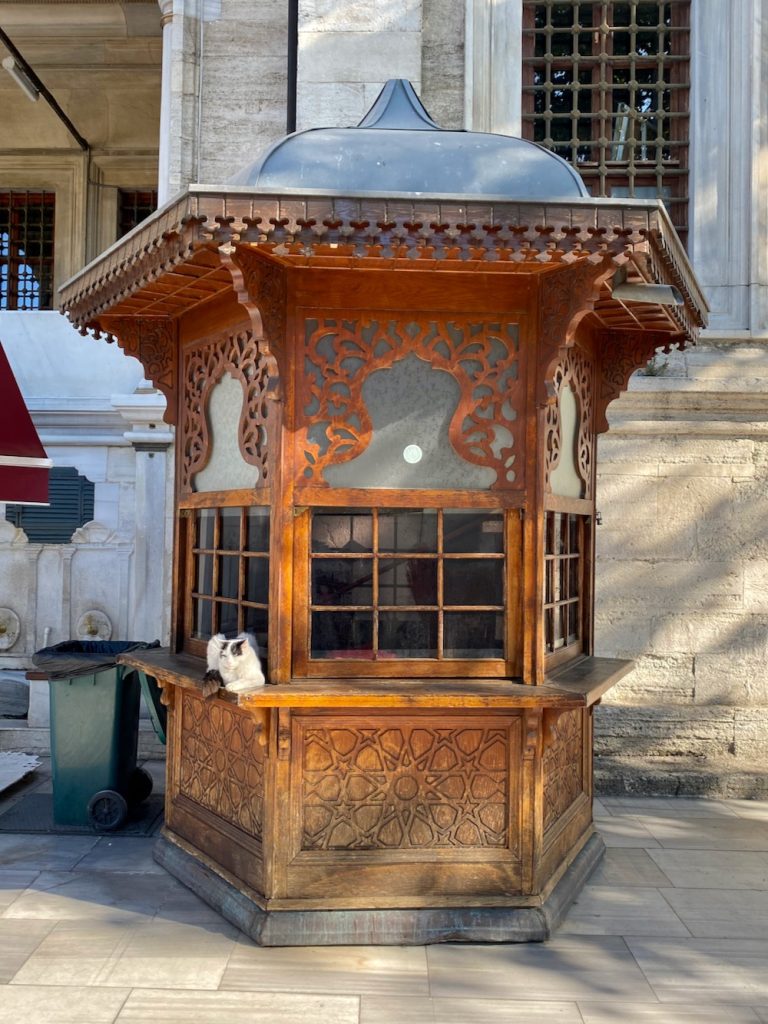
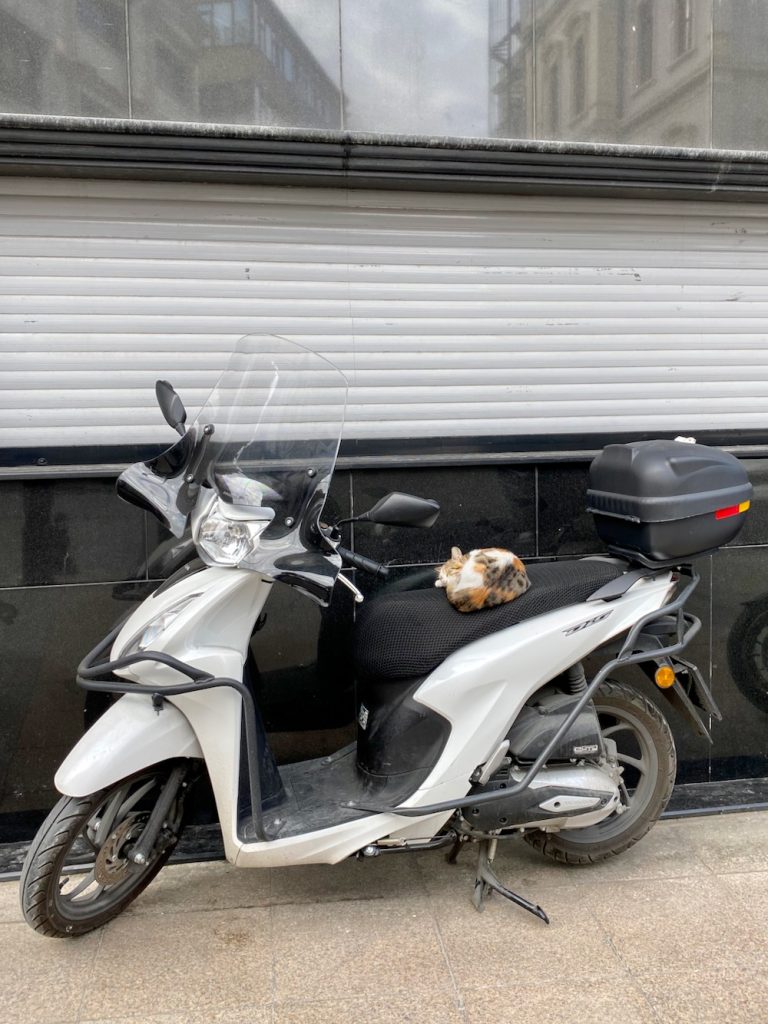
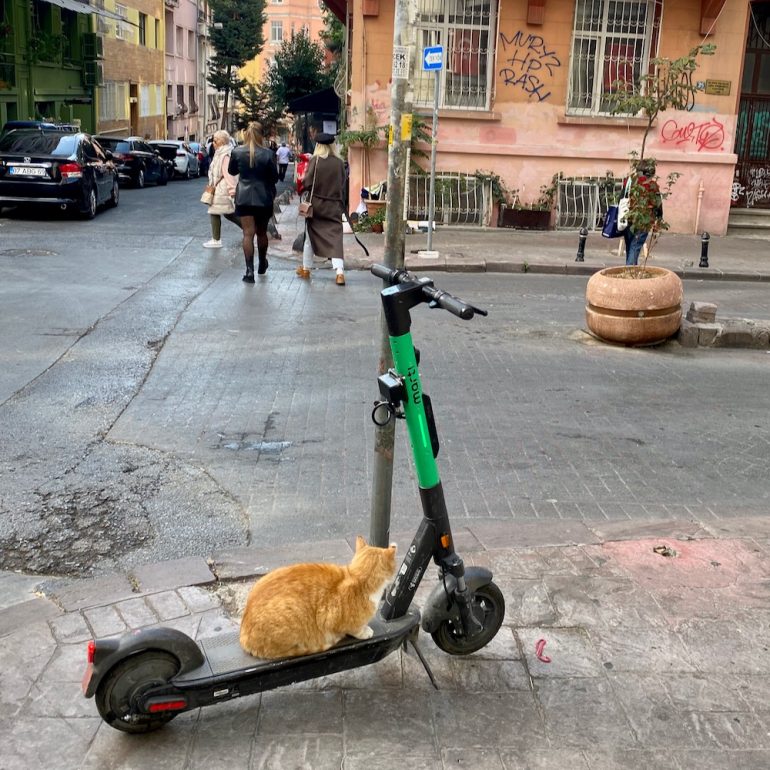
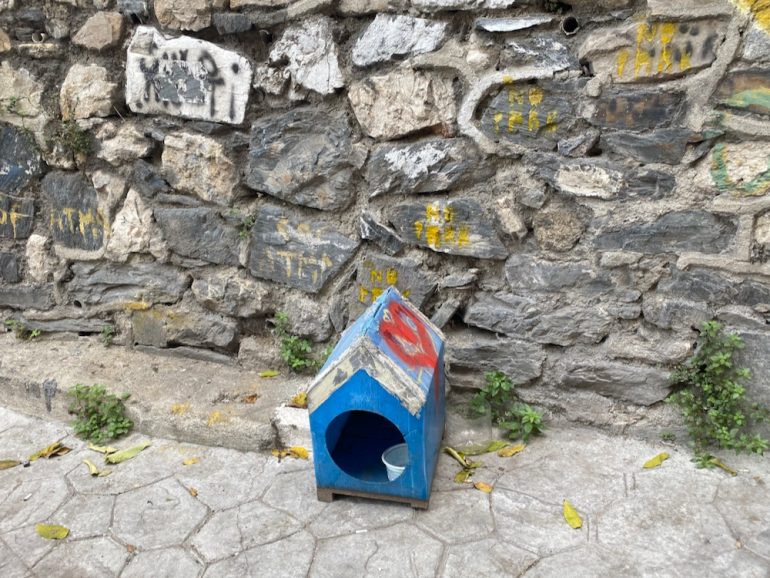
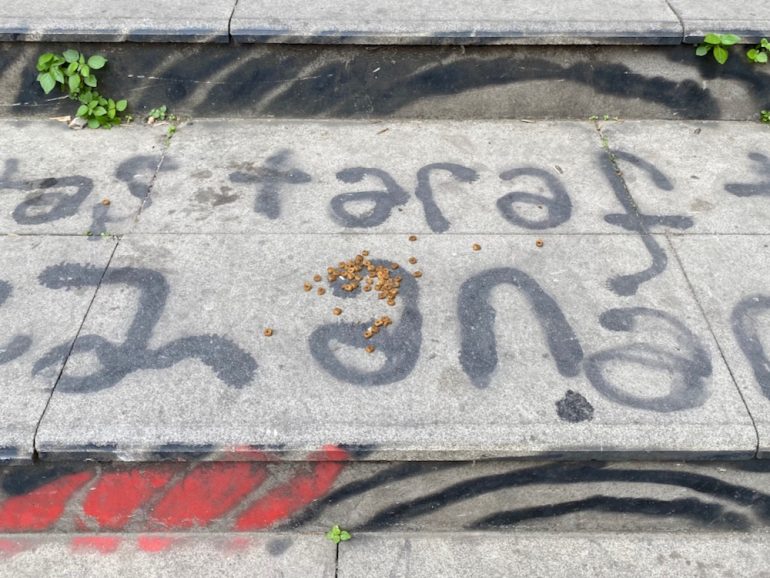 I don’t think we bought any souvenirs, as amusing as certain shop names were….
I don’t think we bought any souvenirs, as amusing as certain shop names were….
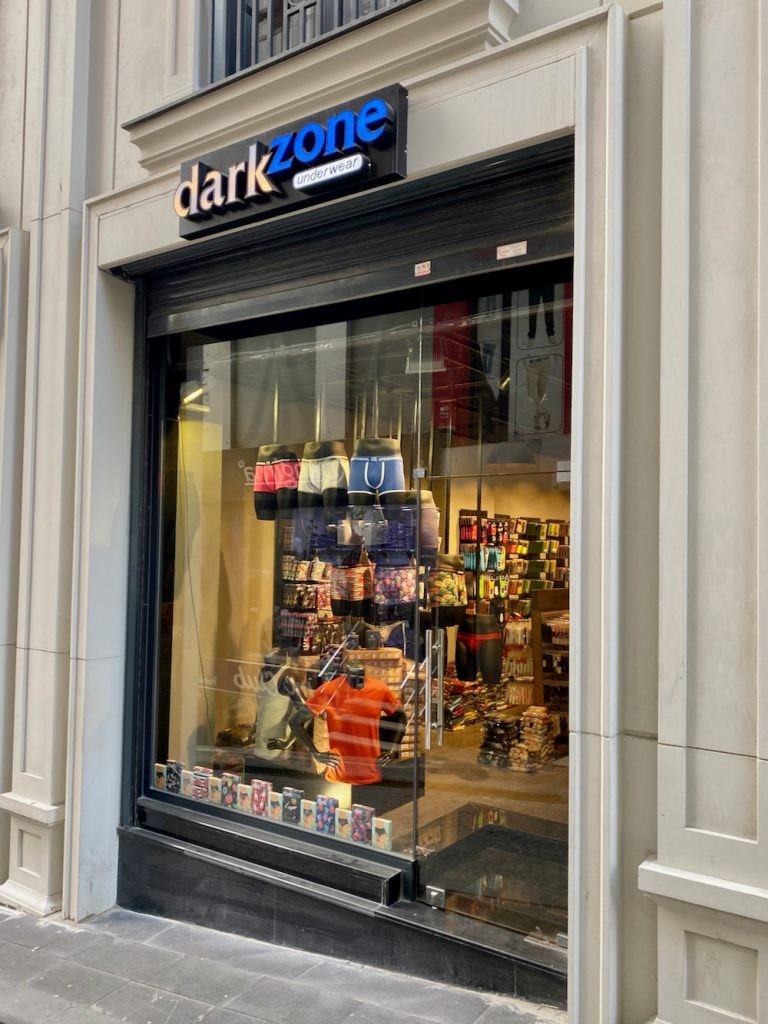 I did insist we go to a supermarket, where I added to my collection of local chip flavors (“a rare deviation from the standard triangular shapes while promising a flavor of poppy seeds and dried tomato,” according to snack blog Taquitos.net) and discovered a new way to say “nuts.”
I did insist we go to a supermarket, where I added to my collection of local chip flavors (“a rare deviation from the standard triangular shapes while promising a flavor of poppy seeds and dried tomato,” according to snack blog Taquitos.net) and discovered a new way to say “nuts.”
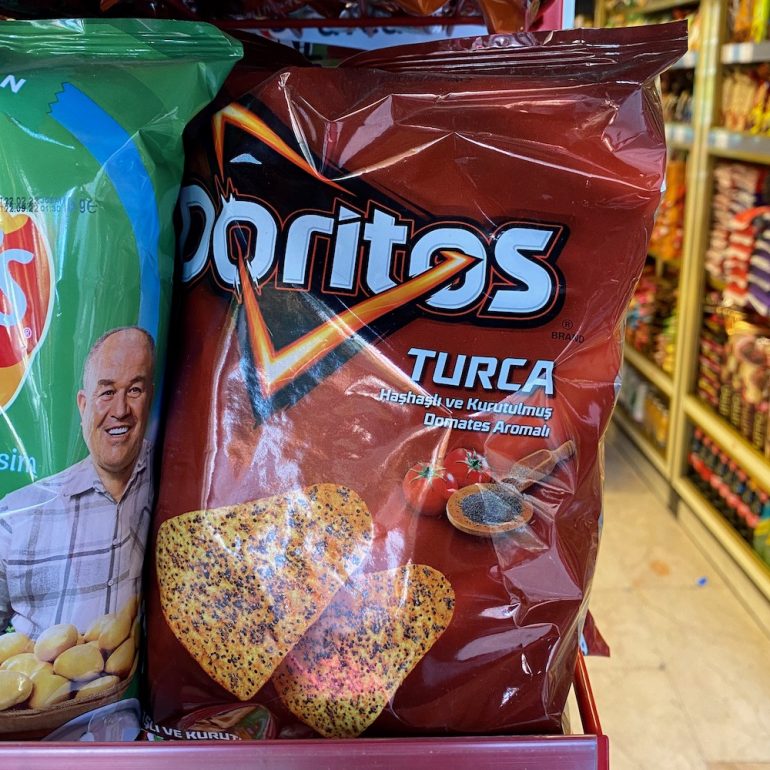
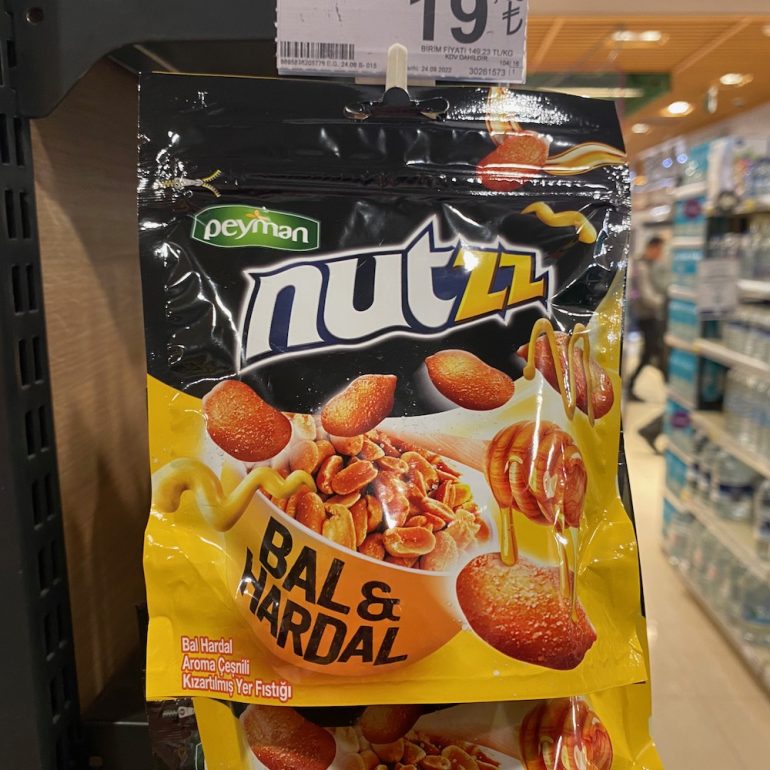
And this made name me laugh.
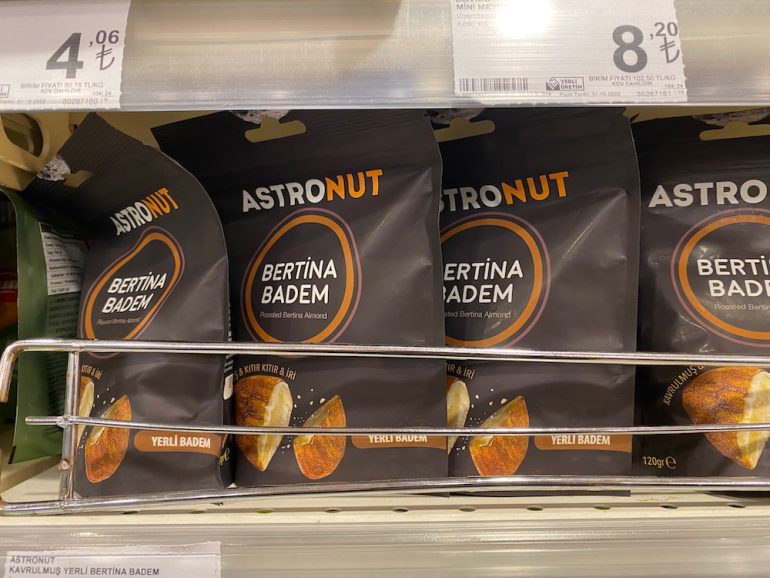 Adam made an effort to learn how to say “thank you” in Turkish, but I didn’t; everyone spoke English well. I did, however, take great enjoyment from all the words that are clearly related to English: polis, taksi, turizm, butik, otomatik, rezervasyon….
Adam made an effort to learn how to say “thank you” in Turkish, but I didn’t; everyone spoke English well. I did, however, take great enjoyment from all the words that are clearly related to English: polis, taksi, turizm, butik, otomatik, rezervasyon….
If you know anything about Istanbul, it’s probably that it straddles Europe and Asia (and that it used to be called Constantinople). It seemed important to go to the Asian side, and we enjoyed it enough, although there aren’t really attractions, per se. Mysteries abounded: Who is the woman on a butcher’s case in a food market? How did we end up in the bridal district? Has Burger King lost its mind?
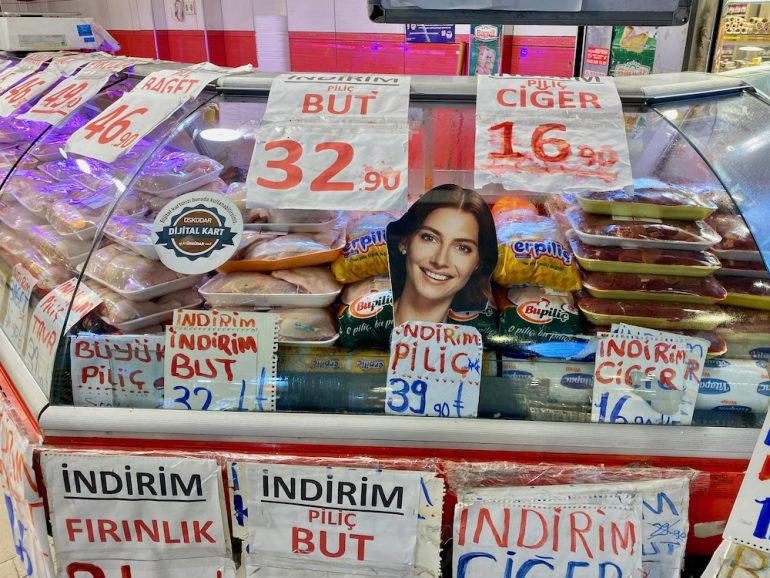
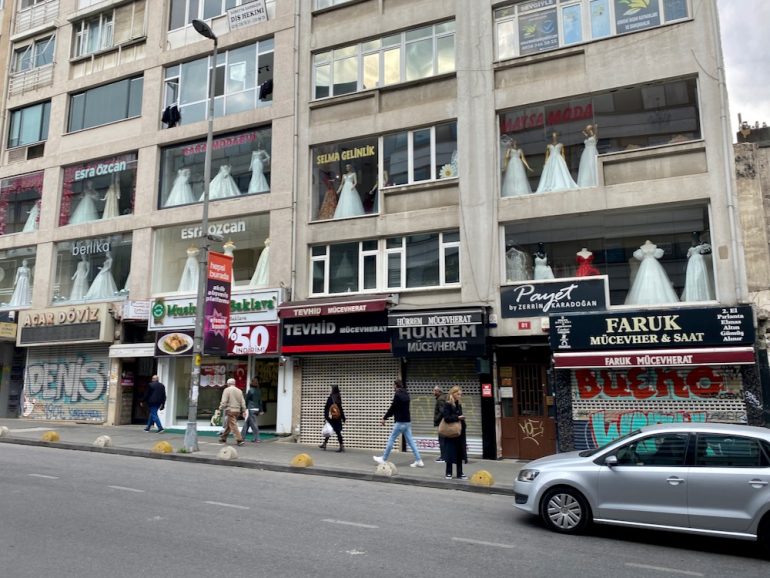
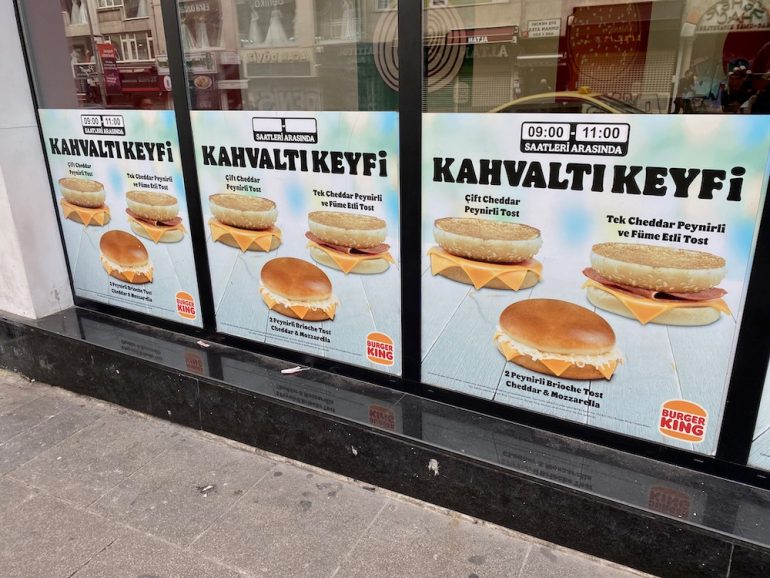 And we had a tasty lunch at Çiya Sofrasi, which the hotel concierge recommended and is also clearly in guidebooks and other media, based on the patrons all around us. We thought we were ordering a vegetarian array, but four of the five dishes included lamb.
And we had a tasty lunch at Çiya Sofrasi, which the hotel concierge recommended and is also clearly in guidebooks and other media, based on the patrons all around us. We thought we were ordering a vegetarian array, but four of the five dishes included lamb.
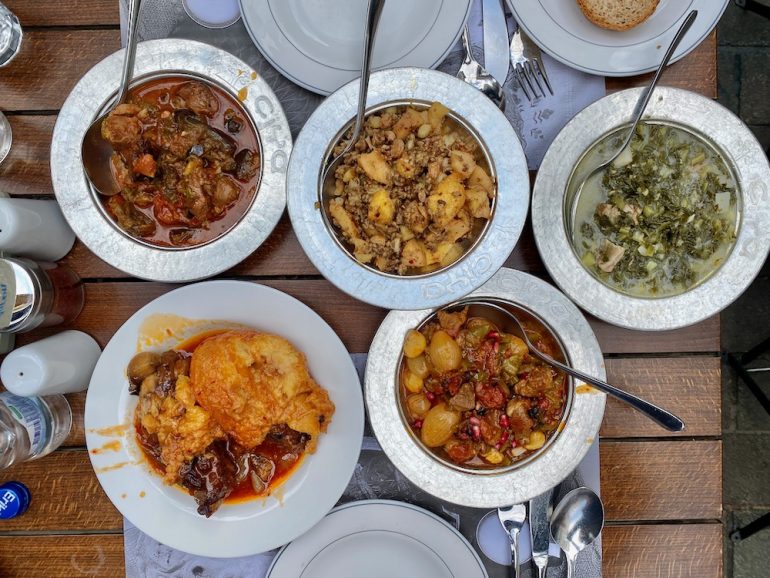 I’m not sure whether this theory holds, but I got the impression that the older a sweet shop is, the better it is. Ali Muhiddin Haci Bekir certainly was beautiful. We bought clove-flavored Turkish delight; it’s what inspired the gumdrops we know as Spice Drops.
I’m not sure whether this theory holds, but I got the impression that the older a sweet shop is, the better it is. Ali Muhiddin Haci Bekir certainly was beautiful. We bought clove-flavored Turkish delight; it’s what inspired the gumdrops we know as Spice Drops.
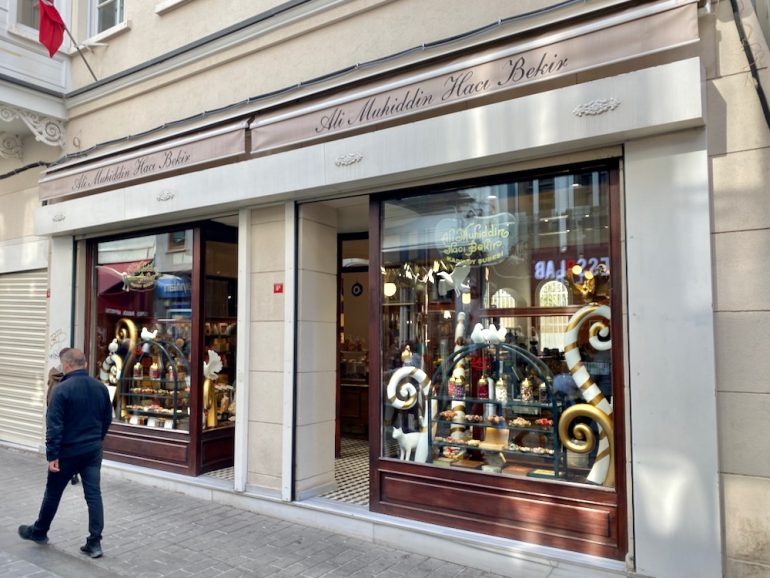
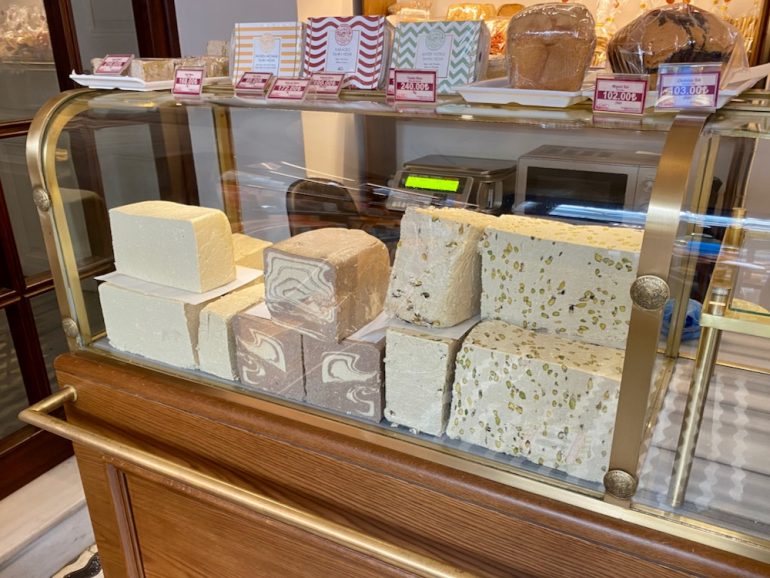
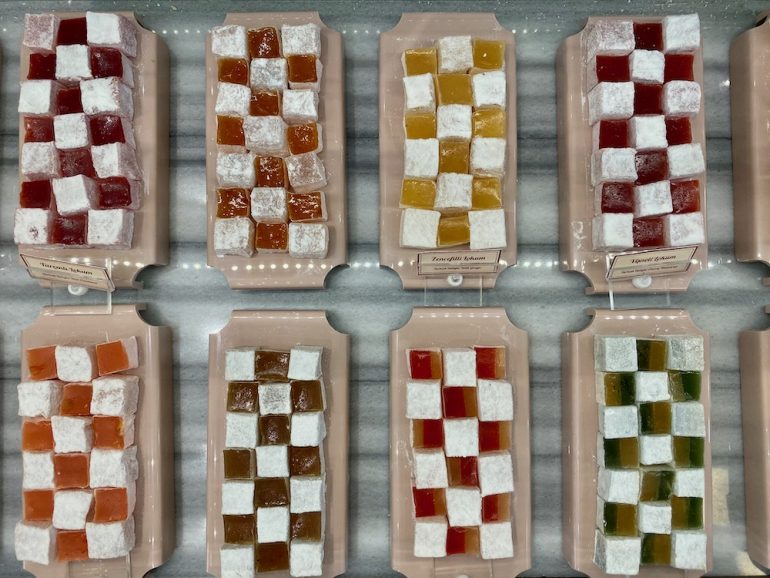 The city felt very safe, even at night and even after a scam artist tried to swindle me. (He dropped a shoeshine brush near me, and when I handed it to him, he crouched down and insisted on giving me a shoeshine, which I refused. Not my first time at the rodeo.) In fact, and I don’t think this is just hindsight, the only time we really thought about crime or terrorism was when we walked to dinner at Yeni Lokanta via a crowded shopping street called Istiklal Avenue. Cars and pedestrians often share the roadway, and part of us—for good reason—wondered whether pedestrians are vulnerable to an attack by car. We were right in general but wrong in the details: the next night, someone set off a bomb on Istiklal Avenue, killing six people and injuring 81 others. (The government blamed Kurdish separatists.) It was unsettling, but I think we all know by now that mass violence can happen anywhere.
The city felt very safe, even at night and even after a scam artist tried to swindle me. (He dropped a shoeshine brush near me, and when I handed it to him, he crouched down and insisted on giving me a shoeshine, which I refused. Not my first time at the rodeo.) In fact, and I don’t think this is just hindsight, the only time we really thought about crime or terrorism was when we walked to dinner at Yeni Lokanta via a crowded shopping street called Istiklal Avenue. Cars and pedestrians often share the roadway, and part of us—for good reason—wondered whether pedestrians are vulnerable to an attack by car. We were right in general but wrong in the details: the next night, someone set off a bomb on Istiklal Avenue, killing six people and injuring 81 others. (The government blamed Kurdish separatists.) It was unsettling, but I think we all know by now that mass violence can happen anywhere.
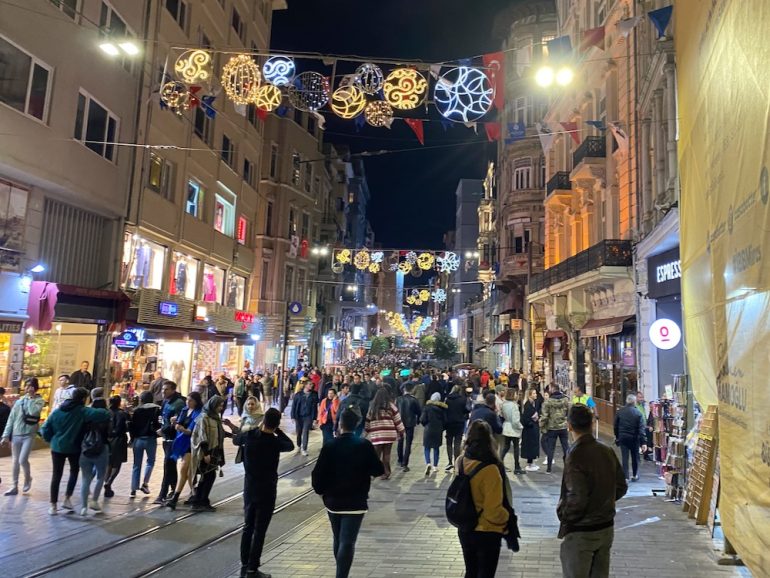 The restaurant we were supposed to go to that night, Aheste, was nearby and had to close. (And we weren’t inclined to venture out anyway—afraid as much of a police overreaction as of another incident.) Aheste looked like the kind of restaurant we love: excellent food in a relaxed setting. The closest we got on the trip was at Mürver. The dishes below are fava purée and roasted celery root.
The restaurant we were supposed to go to that night, Aheste, was nearby and had to close. (And we weren’t inclined to venture out anyway—afraid as much of a police overreaction as of another incident.) Aheste looked like the kind of restaurant we love: excellent food in a relaxed setting. The closest we got on the trip was at Mürver. The dishes below are fava purée and roasted celery root.
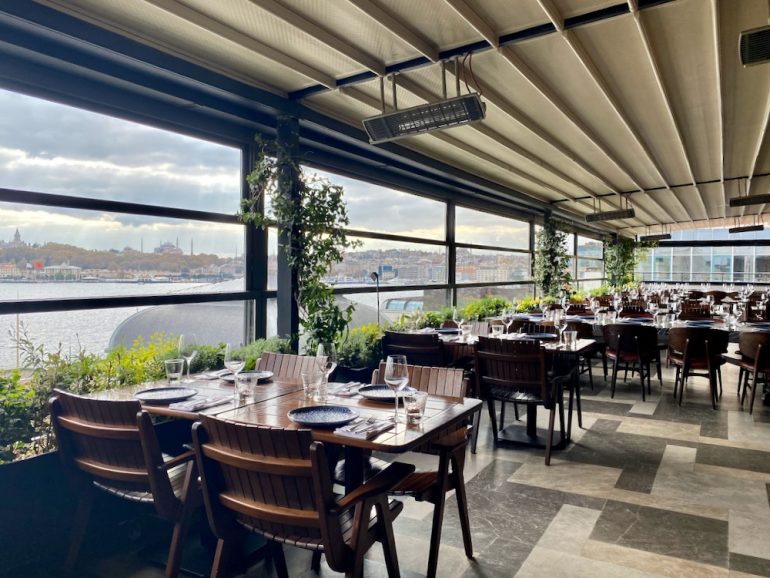
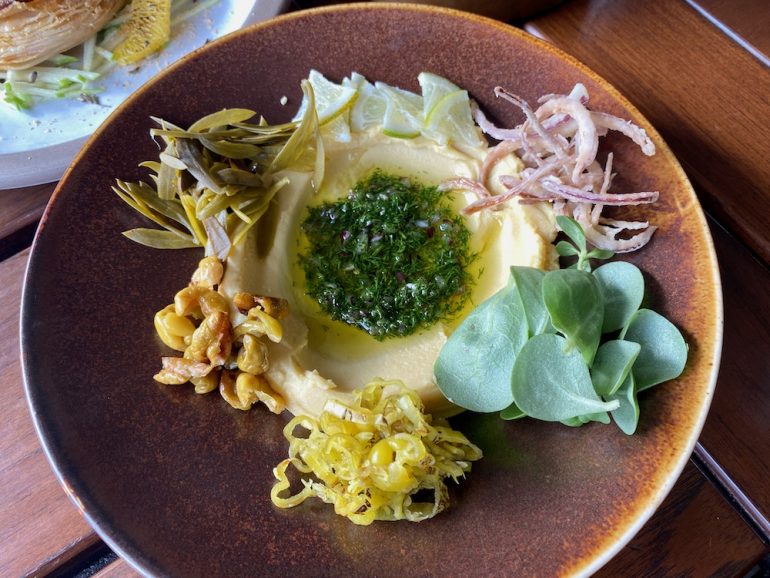
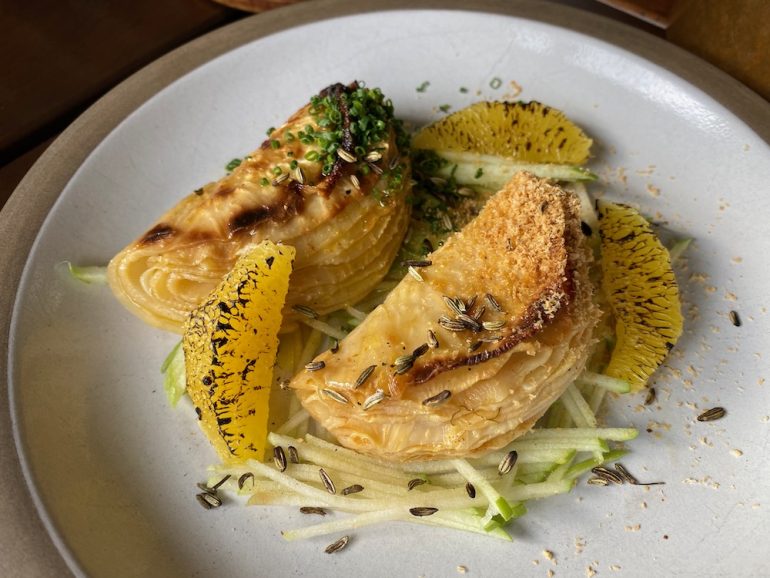 And Mürver has the virtue of being up the street from Karaköy Güllüoğlu. It’s like a midcentury cafeteria dedicated to baklava.
And Mürver has the virtue of being up the street from Karaköy Güllüoğlu. It’s like a midcentury cafeteria dedicated to baklava.
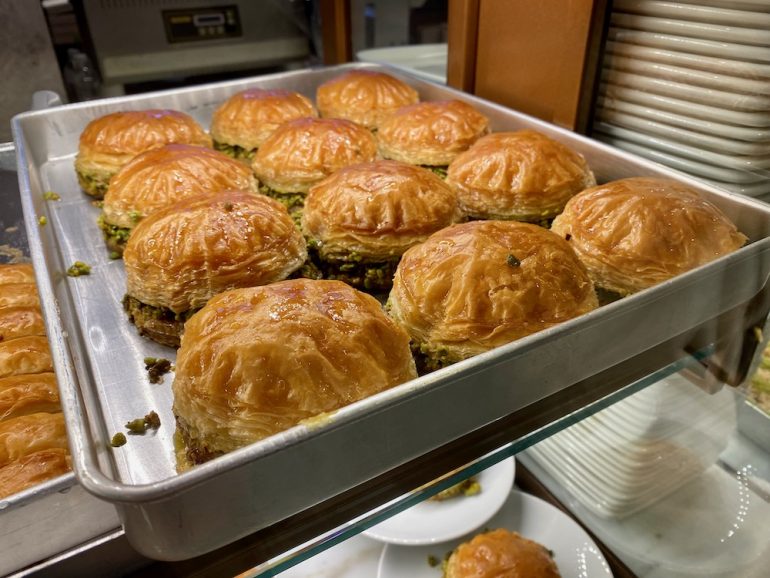
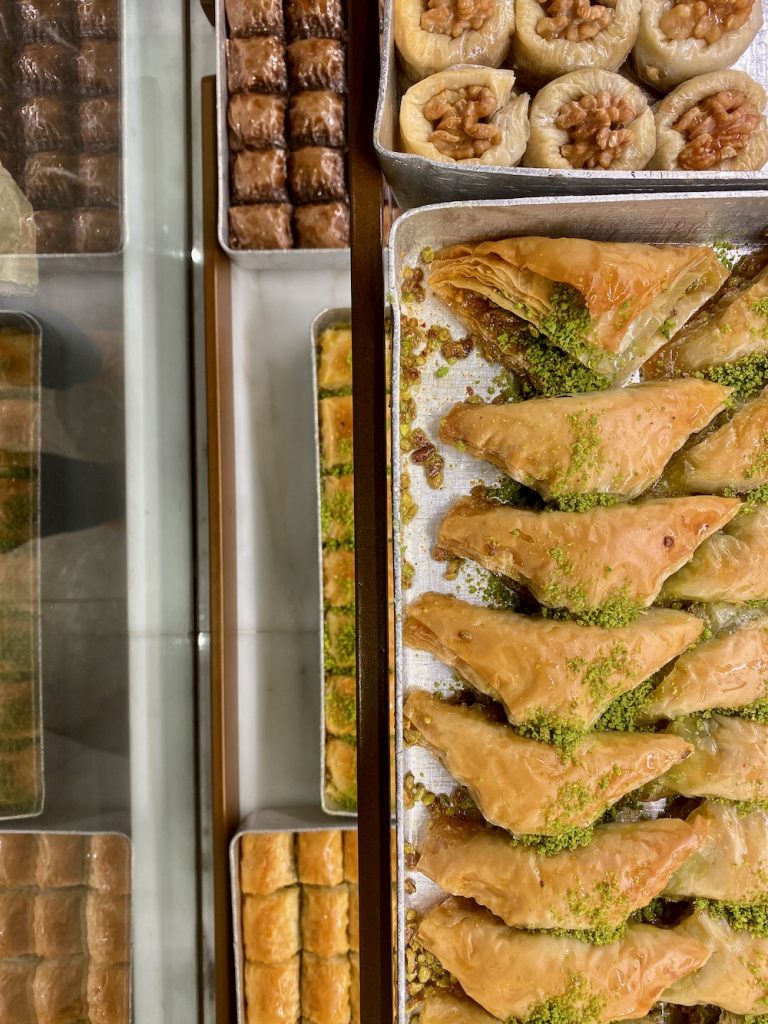 While I can’t wholeheartedly recommend the food at Giritli, it was a short walk from the hotel, the courtyard setting was splendid, and there are cats everywhere—especially if you order (and share) the fried anchovies.
While I can’t wholeheartedly recommend the food at Giritli, it was a short walk from the hotel, the courtyard setting was splendid, and there are cats everywhere—especially if you order (and share) the fried anchovies.
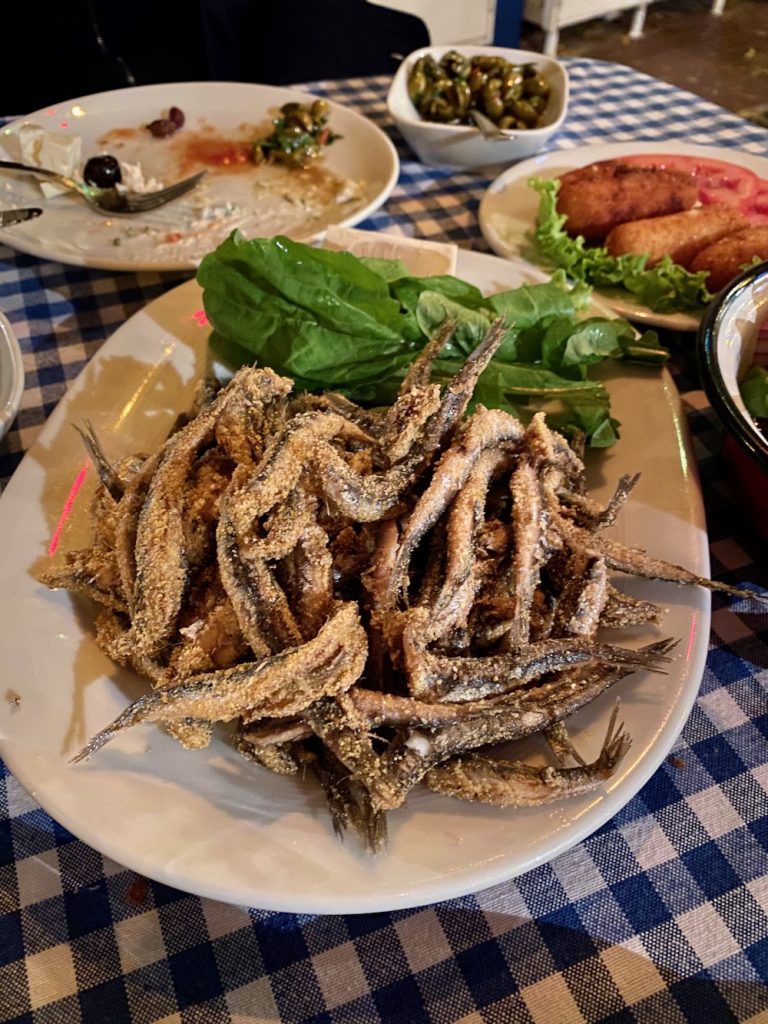
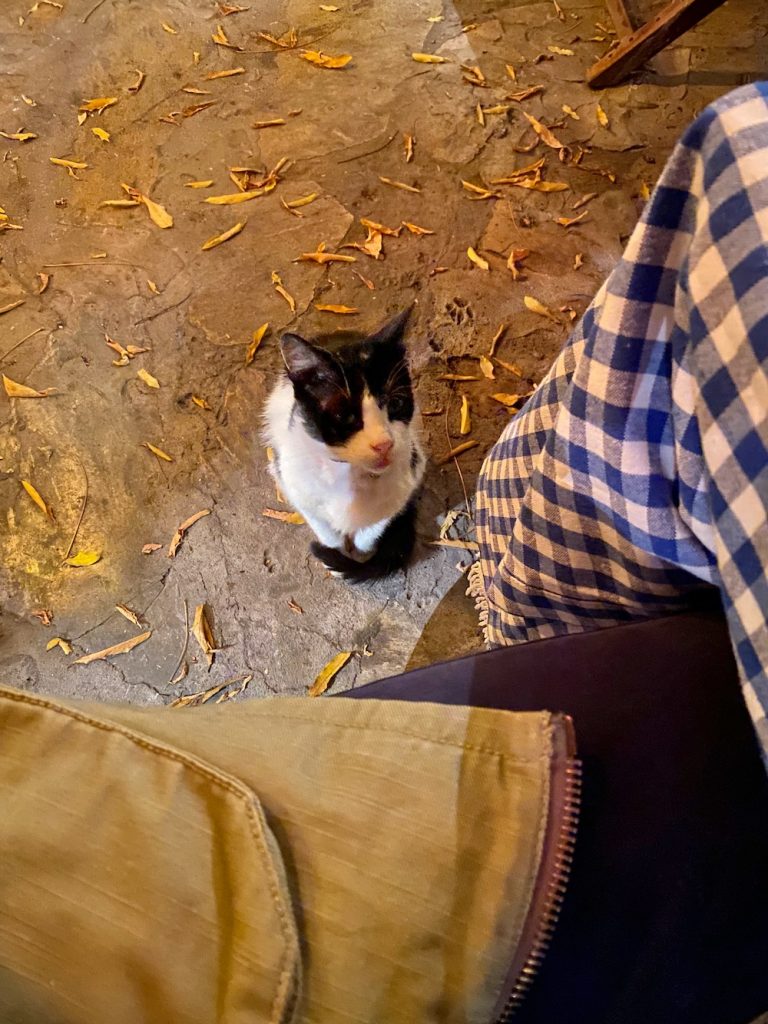 On our last day, we visited the Blue Mosque. As I already mentioned, there wasn’t much to see inside because of construction, but leaving it out of this post seemed weird.
On our last day, we visited the Blue Mosque. As I already mentioned, there wasn’t much to see inside because of construction, but leaving it out of this post seemed weird.
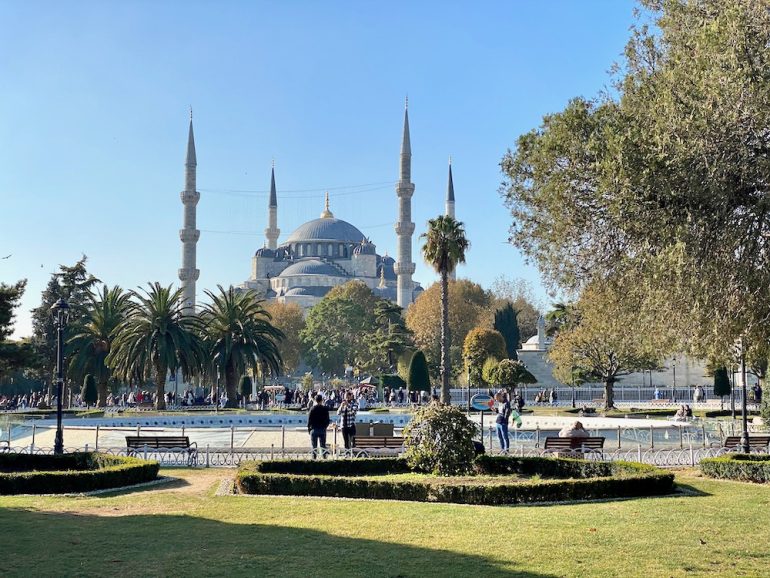
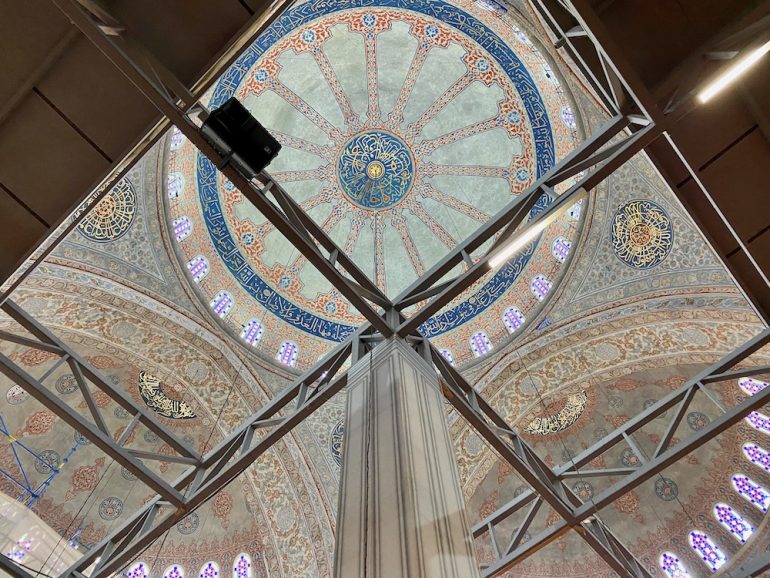 I love a good kitschy photo, and somehow I persuaded Adam to pose for a portrait dressed in sultans’ robes. I had the hope we’d be able to use it as a holiday card—two wise men?—but we looked so awful I refuse to run it here.
I love a good kitschy photo, and somehow I persuaded Adam to pose for a portrait dressed in sultans’ robes. I had the hope we’d be able to use it as a holiday card—two wise men?—but we looked so awful I refuse to run it here.
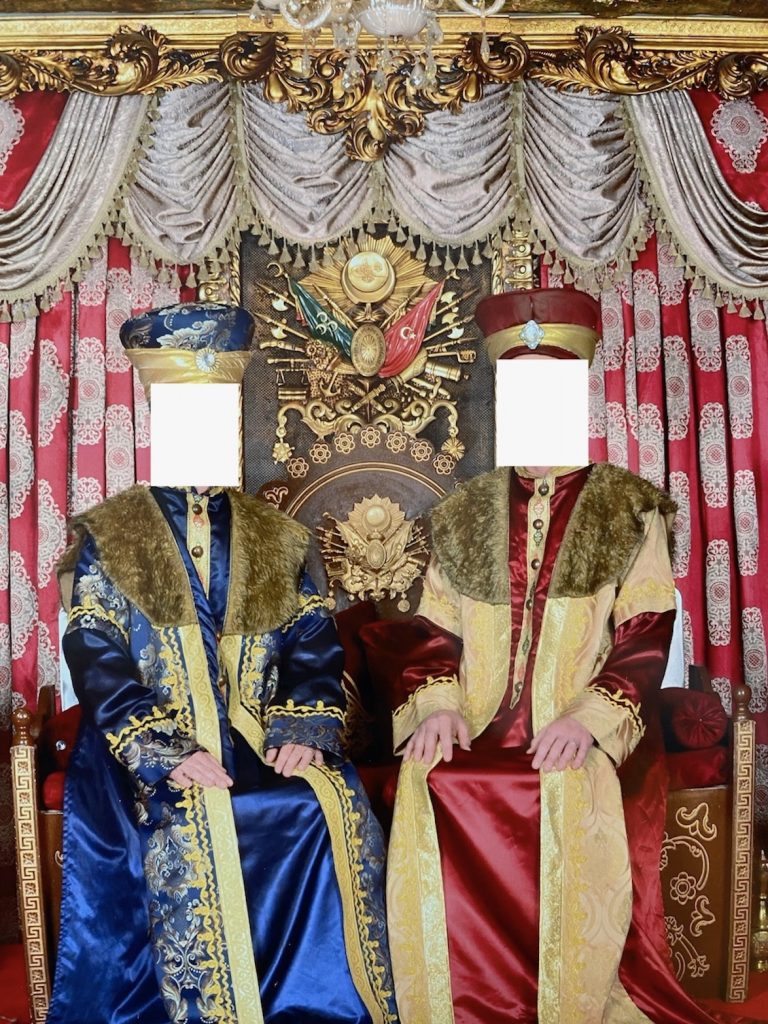 At the last moment, I decided to go to the historic Hurrem Sultan Hamami near the Hagia Sofia. I figured it would be more or less like a spa anywhere in the world, and I could not have been more wrong.
At the last moment, I decided to go to the historic Hurrem Sultan Hamami near the Hagia Sofia. I figured it would be more or less like a spa anywhere in the world, and I could not have been more wrong.
I was given a pair of disposable boxers to wear, along with the towel wrap called a peştamal, and my attendant led me to a marble room where I sat for a while in the heat, next to a sink with water I could use to cool off. Then he came back and scrubbed the living daylights out of my skin, rinsed me off by throwing bowls of water at me, led me to a marble slab where I was instructed to lie down, covered me in suds and lathered me up, gave me a massage, rinsed me off again, and then took me to a daybed where I drank tea and water. All of the aforementioned happened with other patrons around. Then we went to a private cubicle, where I received another massage.
As a spa experience, I enjoyed it: I emerged relaxed and smelling like an entire harem. As a cultural experience, it was off the charts. It felt both touristy and authentic, the kind of thing you’d never do anywhere else. Some of that was due to the near-nudity: most of the time, I wore only the boxers, and the attendant wore only a peştamal. But it was also because the interaction was simultaneously impersonal and extraordinarily intimate. Or maybe it was only intimate for me, to be scrubbed, washed, and dried by another human being. For the attendant, meanwhile, it was just a task; I was just a task. Was this how my dog felt when I gave him a bath?
There are many reasons I love to travel, including seeing something different or new. To feel something different or new, however, is much harder to achieve, and far more rewarding.
Previous travel coverage:
••• Palm Springs: Midweek at the Oasis
••• A Summer Swing Through the Northeast
••• Why Is Everyone Going to Portugal?
••• Patagonia Made Easy
••• A Quickie in L.A.
↓↓↓ From Penthouse to Pavement in Mexico City
••• Do Greek Islands Live Up to the Fantasy?
••• Splendid Isolation at Utah’s Lodge at Blue Sky
••• Three Reasons to Visit Paso Robles Now
••• The Rebirth of the Cuyama Buckhorn
Sign up for the Siteline email newsletter and you’ll never miss a post.


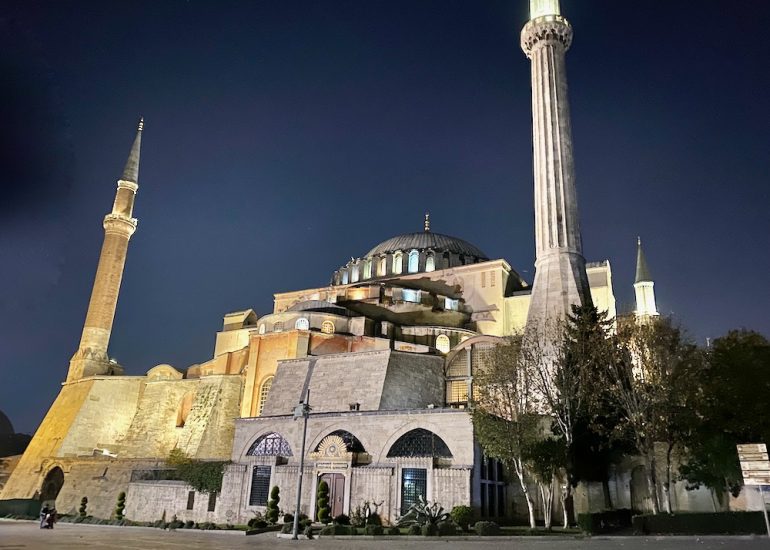
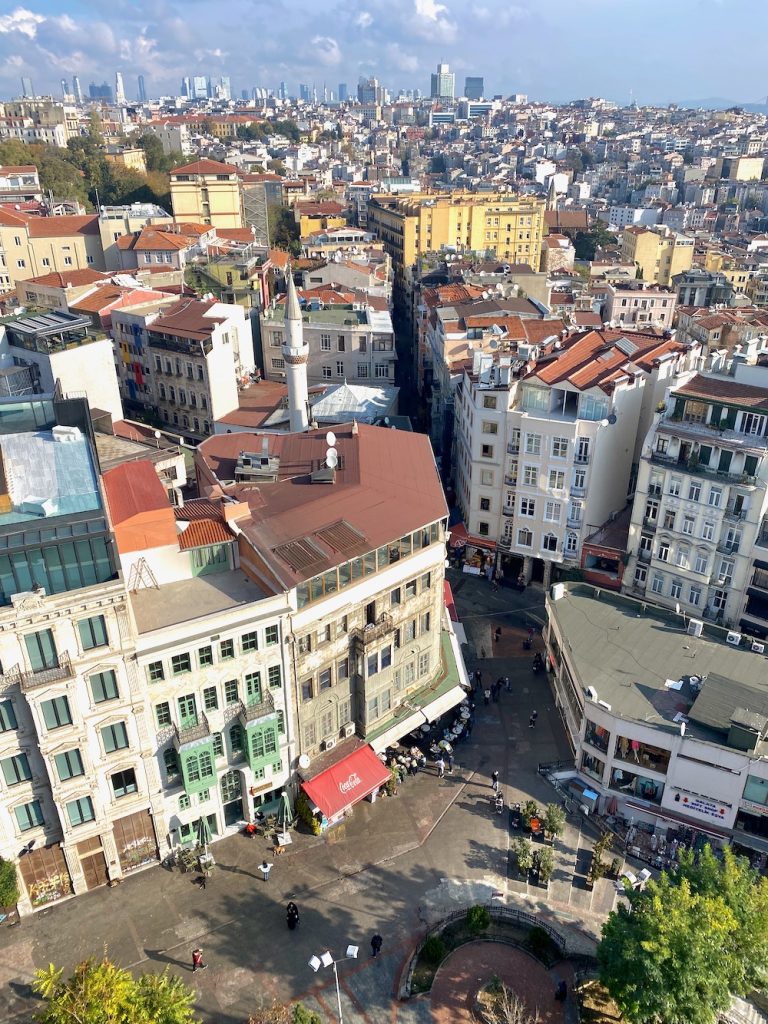
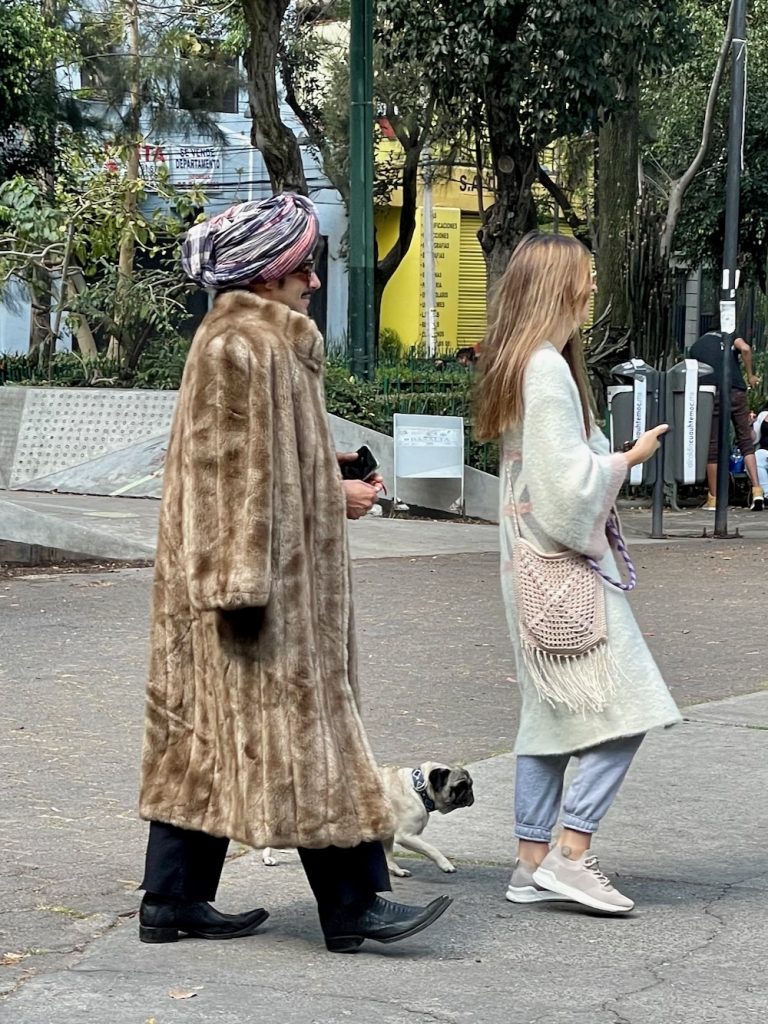











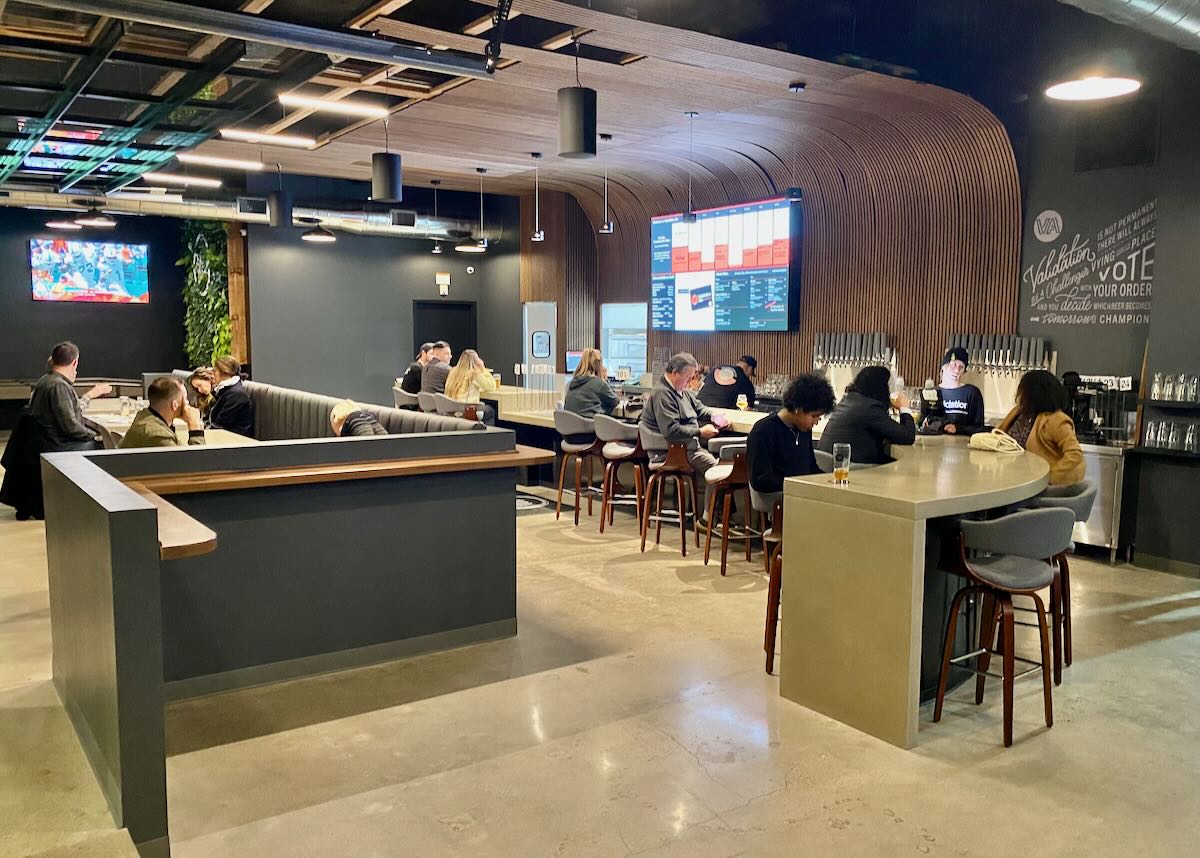
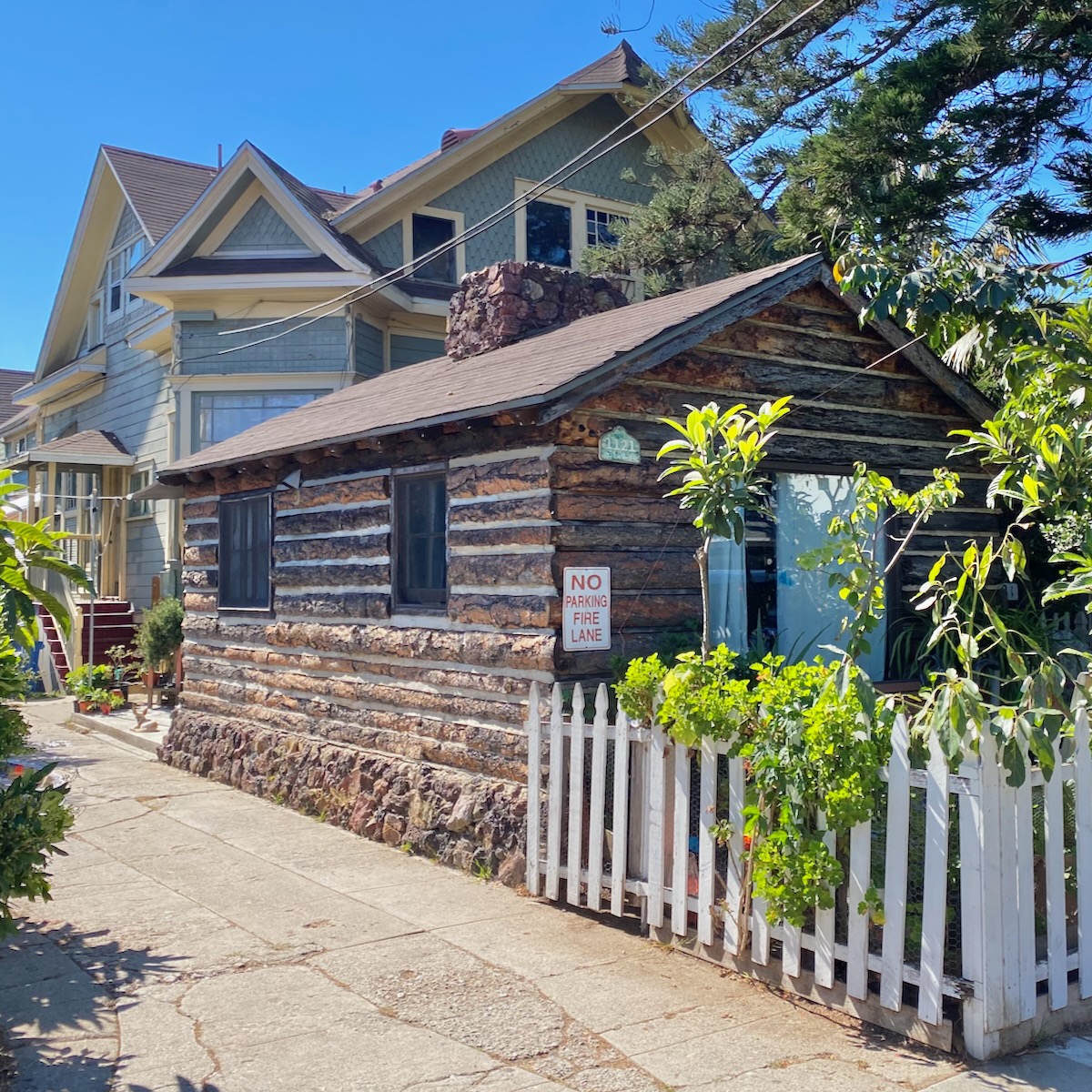


You summarised Istanbul so well! Thank you ❤️
Journalists are so often arrested and jailed in Turkey.
I just have to complement you on all the photos, all your descriptions, and it sounds like you like to travel as I do. Yes, being trapped into one of those rug places was not what I wanted either. Trying to get out was even harder. It was years ago that we were there and it was wonderful and you just brought it all back to me. Thank you so much.